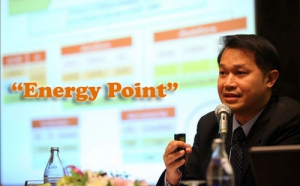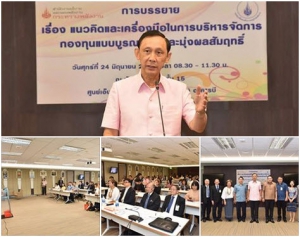Super User
การเปลี่ยนแปลงราคาน้ำมัน 1 กรกฎาคม 2559
การเปลี่ยนแปลงราคาน้ำมัน 29 มิถุนายน 2559
สะสมแต้มพลังงาน “Energy Points” เร่งลดใช้พลังงาน
พลังงานชีวภาพ : พลังแห่งพระปรีชาญาณ
พลังงานชีวภาพ : พลังแห่งพระปรีชาญาณ
นับเป็นความโชคดีอย่างยิ่งของประชาชนชาวไทย ที่ได้เกิดและอาศัยอยู่ภายใต้พระบรมโพธิสมภารในพระบาทสมเด็จพระเจ้าอยู่หัว ผู้ทรงเปี่ยมด้วยพระเมตตาและพระปรีชาสามารถ พระวิสัยทัศน์ด้านพลังงานทดแทนที่ทรงเริ่มต้นศึกษาวิจัยขึ้นเมื่อ 20 ปีที่แล้ว ในขณะที่ราคาน้ำมันดิบในตลาดโลกมีราคาสูงขึ้น ทำให้ปัจจุบันประชาชนชาวไทยได้มีทางเลือกในการใช้พลังงานทดแทนที่คนไทย สามารถผลิตได้เอง สามารถลดปริมาณการนำเข้าได้เป็นจำนวนมาก
คุณแก้วขวัญ วัชโรทัย เลขาธิการสำนักพระราชวัง กล่าวถึงพระราชดำริเรื่องเชื้อเพลิงชีวภาพของพระบาทสมเด็จพระเจ้าอยู่หัวที่ มีมานานกว่าสี่สิบปี ในหนังสือ "๗๒ ปี แก้วขวัญ วัชโรทัย เลขาธิการพระราชวัง" ว่า
"พระองค์ทรงรับสั่งมาตั้งแต่ พ.ศ.๒๕๐๔ แล้วว่าค่ารถจะแพง ก็แปลว่าน้ำมันจะแพง บังเอิญผมรู้จักกับพวกอุตสาหกรรมน้ำมัน แล้วคุยเรื่องนี้ เขาบอกว่าเขาแข่งขันกัน มันก็ต้องลดราคาลงไปเรื่อย ๆ พระองค์ก็รับสั่งให้ทดลองผลิตแอลกอฮอล์ทำน้ำมันเชื้อเพลิง ทำเป็นน้ำมันแก๊สโซฮอล์ ดีโซฮอล์ ในสวนจิตรลดา...
ตอนนั้นทรงมีพระราชปรารภว่าเมืองไทยกำลังเห่อปลูกต้นยูคาลิปตัส ที่ไหน ๆ ก็ปลูกหมด ยูคาลิปตัส ๓ ปี จึงจะตัดได้ แล้วท่านก็รับสั่งว่า ระหว่าง ๓ ปีเขาจะเอาอะไรกิน แต่ถ้าเผื่อปลูกอ้อย ปลูกทุกปีขายได้ทุกปี แล้วก็เอาอ้อยมาทำแอลกอฮอล์ เอาแอลกอฮอล์มาผสมเบนซิน เราก็ทดลองผสมตั้งแต่ ๑๐ เปอร์เซ็นต์ ทั้งเบนซินทั้งน้ำมันดีเซล ใช้ได้รถยนต์ของโครงการส่วนพระองค์ใช้น้ำมันแก๊สโซฮอล์และดีโซลฮอล์"
การศึกษาวิจัยเกี่ยวกับเชื้อเพลิงชีวภาพของโครงการโครงการส่วนพระองค์สวน จิตรลดา เริ่มต้นขึ้นในปี พ.ศ.๒๕๒๘ ด้วยพระบาทสมเด็จพระเจ้าอยู่หัวทรงมีพระราชดำริว่าในอนาคตอาจเกิดการขาดแคลน น้ำมัน จึงมีประราชประสงค์ให้นำอ้อยมาผลิตแอลกอฮอล์เพื่อใช้เป็นเชื้อเพลิง โดยพระราชทานเงินทุนวิจัยเริ่มต้นเป็นจำนวน ๙๒๕,๕๐๐ บาท
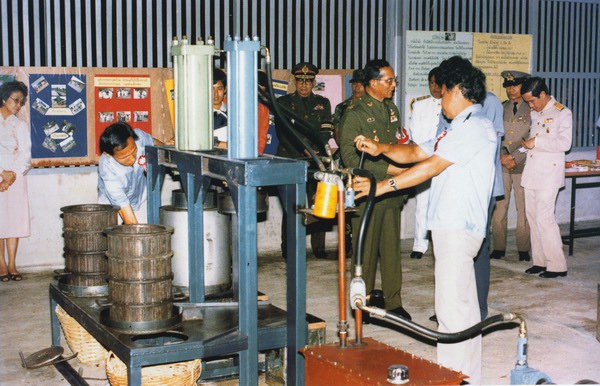
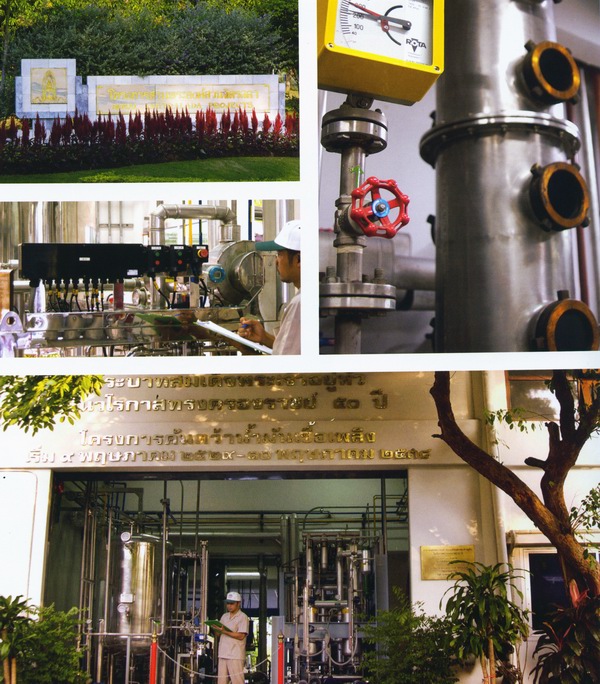
เอทานอล
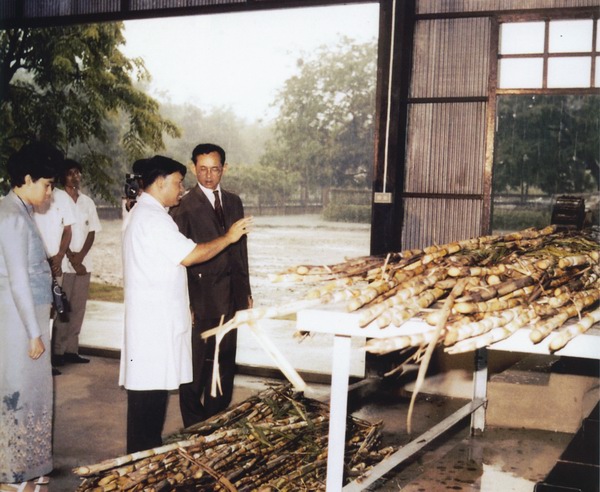
การศึกษาวิจัยภายในโครงการส่วนพระองค์สวนจิตรลดาเริ่มตั้งแต่การทดลอง ปลูกอ้อยหลายพันธุ์ เพื่อคัดเลือกพันธุ์ที่ดีที่สุดนำมาทำแอลกอฮอล์ นอกจากอ้อยที่ผลิตได้ภายในโครงการส่วนพระองค์สวนจิตรลดาแล้วยังออกไปรับซื้อ อ้อยจากเกษตรกรเพื่อนำมาเป็นวัตถุดิบอีกด้วย
โรงงานแอลกอฮอล์ซึ่งมีทั้งเครื่องหีบอ้อย ถังหมัก หอกลั่นขนาดเล็ก เริ่มเดินเครื่องการผลิตครั้งแรกในปี พ.ศ.๒๕๒๙ สามารถผลิตแอลกอฮอล์ ๙๑ เปอร์เซ็นต์ได้ในอัตรา ๒.๘ ลิตรต่อชั่วโมง
ต่อมาเนื่องจากวัตถุดิบมีไม่เพียงพอ จึงเปลี่ยนมาใช้กากน้ำตาล และมีการสร้างอาคารศึกษาวิจังหลังใหม่ภายในโครงการส่วนพระองค์สวนจิตรลดา
สำหรับแอลกอฮอล์ที่ผลิตได้ในช่วงแรกยังไม่สามารถนำไปผสมกับเบนซินได้ จึงนำผลผลิตที่ได้ไปทำเป็นน้ำส้มสายชูต่อมาก็ทำเป็นแอลกอฮอล์แข็งใช้อุ่น อาหารให้กับทางห้องเครื่องของสวนจิตรลดา เนื่องจากเดิมใช้แอลกอฮอล์เหลว ครั้งหนึ่งเมื่อมีการขนส่งแอลกอฮอล์เหลวไปยังพระตำหนักในภาคเหนือ รถเกิดอุบัติเหตุทกให้ไฟไหม้รถทั้งคัน เพราะแอลกอฮอล์เป็นเชื้อเพลิงอย่างดี จึงได้มีการคิดนำแอลกอฮอล์มาทำเป็นเชื้อเพลิงแข็งเพื่อความปลอดภัยแทน
โรงงานแอลกอฮอล์มีการปรับปรุงการกลั่นเรื่อยมาต่อมาก็สามารถผลิต แอลกอฮอล์บริสุทธิ์ ๙๕ เปอร์เซ็นต์ หรือที่เรียกว่าเอทานอลได้เป็นผลสำเร็จ
วัตถุดิบที่ใช้ในการผลิตเอทานอล
วัตถุดิบที่ใช้ผลิตเอทานอลแบ่งออกเป็น ๓ ประเภทใหญ่ ๆ ดังนี้ คือ
1.วัตถุดิบประเภทแป้ง ได้แก่ ธัญพืช ข้าวเจ้า ข้าวสาลี ข้าวโพด ข้าวบาร์เลย์ ข้าวฟ่าง และพวกพืชหัว เช่น มันสำปะหลัง มันฝรั่ง มันเทศ เป็นต้น
2.วัตถุดิบประเภทน้ำตาล ได้แก่ อ้อย กากน้ำตาล บีตรูต ข้าวฟ่างหวาน เป็นต้น
3.วัตถุดิบประเภทเส้นใย ส่วนใหญ่เป็นผลพลอยได้จากผลผลิตทางการเกษตร เช่น ฟางข้าว ชานอ้อย ซังข้าวโพด รำข้าว เศษไม้ เศษกระดาษ ขี้เลื่อย วัชพืช รวมทั้งของเสียจากโรงงานอุตสาหกรรม เช่น โรงงานกระดาษ เป็นต้น
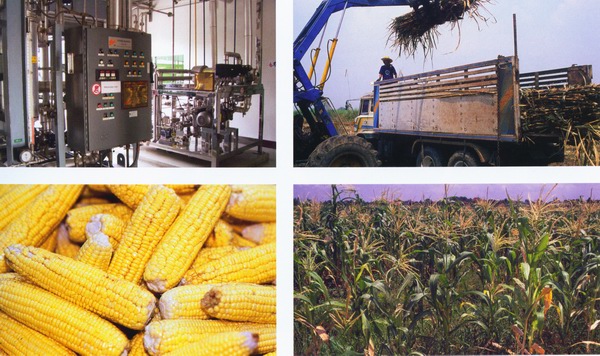

เมื่อโรงงานแอลกอฮอล์ของโครงการส่วนพระองค์สวนจิตรลดาสามารถผลิต แอลกอฮอล์บริสุทธิ์ ๙๕ เปอร์เซ็นต์ และทดลองนำไปผสมกับน้ำมันเบนซินเติมเครื่องยนต์ แต่ไม่ประสบความสำเร็จ เพราะแอลกอฮอล์บริสุทธิ์ ๙๕ เปอร์เซ็นต์มีน้ำผสมอยู่ด้วย ต้องนำไปกลั่นแยกน้ำเพื่อให้ได้แอลกอฮอล์บริสุทธิ์ ๙๙.๕ เปอร์เซ็นต์ หรือเอทานอล ก่อนนำไปผสมกับน้ำมันเบนซิน
โครงการส่วนพระองค์สวนจิตรลดาจึงนำแอลกอฮอล์บริสุทธิ์ ๙๕ เปอร์เซ็นต์ไปผ่านกระบวนการแยกน้ำที่สถาบันวิจัยวิทยาศาสตร์และเทคโนโลยี แห่งประเทศไทยเพื่อให้ได้เอทานอล และนำกลับมาผสมกับน้ำมันเบนซินที่โครงการส่วนพระองค์สวนจิตรลดา
ปี พ.ศ.๒๕๓๗ โครงการส่วนพระองค์สวนจิตรลดาขยายกำลังการผลิตเอทานอลเพื่อให้มีปริมาณเพียง พอผสมกับน้ำมันเบนซิน ๙๑ ในอัตราส่วน ๑ : ๙ ได้เป็นน้ำมันแก๊สโซฮอล์ เติมให้กับรถยนต์ทุกคันของโครงการส่วนพระองค์สวนจิตรลดา ซึ่งเป็นหนึ่งในหกโครงการเฉลิมพระเกียรติ เนื่องในวโรกาสที่พระบาทสมเด็จพระเจ้าอยู่หัวทรงครองสิริราชสมบัติครบ ๕๐ ปี ของสำนักพระราชวัง
เมื่อวันที่ ๑๐ พฤษภาคม พ.ศ.๒๕๓๘ สมเด็จพระเทพรัตนราชสุดาฯ สยามบรมราชกุมารี เสด็จพระราชดำเนินไปทรงเปิดโรงงานผลิตแอลกอฮอล์เป็นเชื้อเพลิง โดยโรงกลั่นใหม่นี้มีกำลังการผลิตแอลกอฮอล์ได้ชั่วโมงละ ๒๕ ลิตรในกระบวนการกลั่นจะได้น้ำกากส่าเป็นน้ำเสีย ซึ่งส่วนหนึ่งใช้รดกองปุ๋ยหมักของโรงงานปุ๋ยอินทรีย์
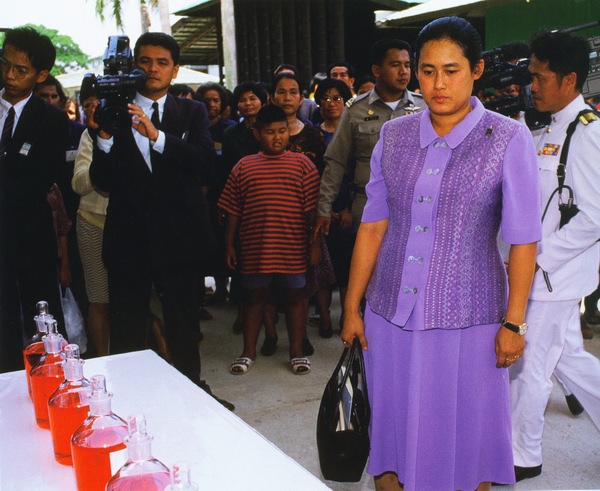
การผสมแอลกอฮอล์กับเบนซินของโครงการส่วนพระองค์สวนจิตรลดาในระยะแรกเป็น การนำน้ำมันและเอทานอลมาผสมในถังธรรมดา ใช้แรงงานคนเขย่าให้เข้ากัน ต่อมาบริษัท ปตท. จำกัด (มหาชน) (การปิโตรเลียมแห่งประเทศไทยในเวลานั้น) จึงน้อมเกล้าน้อมกระหม่อมถวายหอผสมและสถานีบริการน้ำมันแก๊สโซฮอล์แก่ โครงการส่วนพระองค์สวนจิตรลดา
ปี พ.ศ.๒๕๔๔ ภาคเอกชน ๒ กลุ่ม น้อมเกล้าน้อมกระหม่อมถวายเครื่องแยกน้ำออกจากเอทานอล (Dehydration Unit) ๒ แบบ คือ เครื่อง Molecular Sieve Dehydration Unit และเครื่อง Membrane Dehydration Unit
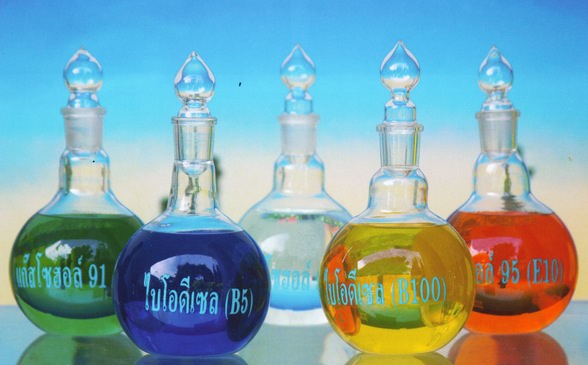
ปัจจุบันสถานีบริการเชื้อเพลิงในโครงการส่วนพระองค์สวนจิตรลดา นอกจากผลิตน้ำมันแก๊สโซฮอล์เติมให้กับรถยนต์ทุกคันของโครงการแล้ว งานทดลองผลิตภัณฑ์เชื้อเพลิงของโครงการส่วนพระองค์สวนจิตรลดายังเป็นแหล่ง ความรู้แก่ประชาชนที่สนใจอีกด้วย
ขั้นตอนการผลิตน้ำมันแก๊สโซฮอล์และสูตรการผสมที่โครงการส่วนพระองค์สวนจิตรลดา
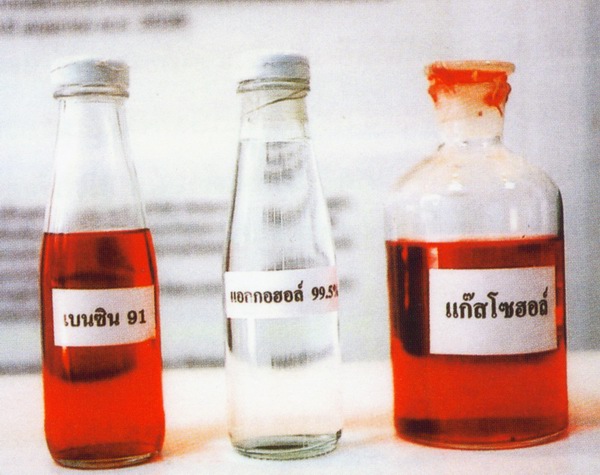
ขั้นตอนการผลิตน้ำมันแก๊สโซฮอล์ในเชิงพาณิชย์
นำวัตถุดิบอย่างเช่นข้าว ข้าวโพด มันสำปะหลัง อ้อย ข้าวฟ่างหวาน ฯลฯ ไปผ่านกระบวนการหมัก จากนั้นนำไปผ่านกระบวนการกลั่นและแยกให้บริสุทธิ์ ซึ่งจะทำให้ได้เอทานอล ๙๕ เปอร์เซ็นต์ หลังจากนั้นนำไปผ่านกระบวนการแยกน้ำ ทำให้ได้เป็นเอทานอล ๙๙.๕ เปอร์เซ็นต์ ก่อนนำไปผสมกับน้ำมันเบนซิน ถ้าผสมกับน้ำมันเบนซิน ๘๗ ก็จะได้เป็นน้ำมันแก๊สโซฮอล์ ๙๑ ถ้าผสมกับน้ำมันเบนซิน ๙๑ ก็จะได้เป็นน้ำมันแก๊สโซฮอล์ ๙๕

จากพระราชดำริสู่ประชาชน
ช่วงปี พ.ศ.๒๕๒๘-๒๕๓๐ บริษัท ปตท. จำกัด (มหาชน) และบริษัท บางจากปิโตรเลียม จำกัด (มหาชน) เปิดจำหน่ายน้ำมันแก๊สโซฮอล์ได้ระยะหนึ่งก็ต้องหยุดไป เพราะราคาน้ำมันเบนซินในเวลานั้นถูกกว่าราคาแอลกอฮอล์ ๙๕ เปอร์เซ็นต์ จึงไม่คุ้มค่ากับการนำมาจำหน่าย
อย่างไรก็ตาม โครงการส่วนพระองค์สวนจิตรลดายังคงศึกษาวิจัยเกี่ยวกับน้ำมันแก๊สโซฮอล์ อย่างต่อเนื่องมาตลอด ดังนั้นเมื่อเกิดวิกฤตราคาน้ำมัน การนำผลการศึกษาวิจัยเรื่องพลังงานทดแทนตามพระราชดำริมาต่อยอดขยายผลในเชิง พาณิชย์จึงเป็นไปได้อย่างรวดเร็ว
พ.ศ.๒๕๓๙ รัฐบาลมีนโยบายยกเลิกการเติมสารตะกั่วเพื่อแก้ไขปัญหามลพิษทางอากาศ ทำให้โรงกลั่นน้ำมันต้องนำเข้าสารเพิ่มออกเทน MTBE (Methyl Tertiary Butyl Ether) มาผสมกับน้ำมันเบนซินแทน อย่างไรก็ตาม สาร MTBE ซึ่งนอกจากช่วยลดมลพิษทางอากาศแล้ว ยังประหยัดเงินตราต่างประเทศปีละหลายร้อยล้านบาท รวมทั้งช่วยให้เกษตรกรสามารถขายผลิตผลทางเกษตรในราคาสูงขึ้น
พ.ศ.๒๕๔๔ บริษัท ปตท. จำกัด (มหาชน) ร่วมกับโครงการส่วนพระองค์สวนจิตรลดาผลิตและจำหน่ายน้ำมันแก๊สโซฮอล์ โดยเริ่มจำหน่าย ณ สถานีบริการน้ำมัน ปตท.บริเวณสำนักงานใหญ่ ถนนวิภาวดีรังสิต
ปีเดียวกัน บริษัท บางจากปิโตรเลียม จำกัด (มหาชน) ร่วมกับสถาบันวิจัยวิทยาศาสตร์และเทคโนโลยีแห่งประเทศไทย ผลิตเอทานอลบริสุทธิ์ ๙๙.๕ เปอร์เซ็นต์จากมันสำปะหลัง แล้วนำมาผสมกับน้ำมันเบนซินในสัดส่วน ๑๐ เปอร์เซ็นต์ ทดแทนสาร MTBE เป็นน้ำมันแก๊สโซฮอล์ ออกเทน ๙๕
บริษัท บางจากปิโตรเลียม จำกัด (มหาชน) ทดลองจำหน่ายน้ำมันแก๊สโซฮอล์เป็นครั้งแรกที่สถานีบริการน้ำมันถนนติวานนท์ ถนนพหลโยธิน ถนนเจริญกรุงตัดใหม่ และถนนนวมินทร์ ปีถัดมาเปิดเพิ่มขึ้นอีก ๑ แห่ง ที่ถนนสุทธิสารวินิจฉัย
จนกระทั่งปัจจุบันเปิดจำหน่ายทั่วประเทศผ่านสถานีบริการกว่า ๖๐๐ แห่ง รวมถึงนำเอทานอลมาผสมเป็นน้ำมันแก๊สโซฮอล์ ๙๑ เป็นรายแรกและรายเดียวในประเทศไทย ตั้งแต่ปี พ.ศ.๒๕๔๗
ภายในเวลาเพียงไม่กี่ปี น้ำมันแก๊สโซฮอล์ก็ได้รับความนิยมในหมู่ประชาชนทั่วไปอย่างกว้างขวาง ซึ่งนอกจากช่วยลดการนำเข้าน้ำมันลงได้ส่วนหนึ่งแล้ว ยังช่วยลดมลภาวะเป็นพิษในอากาศได้อีกด้วย
"ปตท.ได้เข้าร่วมกับโครงการส่วนพระองค์สวนจิตรลดา โดยทดสอบการใช้น้ำมันแก๊สโซฮอล์ ใช้อัตราส่วนผสมของเอทานอล ๙๙.๕ เปอร์เซ็นต์ และเบนซินธรรมดาเท่ากับ ๑:๙ หรือ ๑๐ เปอร์เซ็นต์ กับรถยนต์ในโครงการส่วนพระองค์ฯ มีรถบรรทุกเครื่องยนต์เบนซินขนาดเล็ก รวมทั้งรถจักรยานยนต์สองและสี่จังหวะ และน้ำมันดีโซฮอล์ใช้อัตราส่วนผสมของเอทานอล ๙๕ เปอร์เซ็นต์ และดีเซลเท่ากับ ๑๔ เปอร์เซ็นต์ โดยเติมกับสารอิมัลซิไฟเออร์ ใช้กับรถบรรทุกเครื่องยนต์ดีเซลขนาดเล็กและรถไถแทรกเตอร์ เครื่องยนต์ Kubota ตลอดจนรถยนต์ดีเซลใช้สำหรับเก็บขยะ...
ผลการทดสอบปรากฏว่า ตลอดระยะเวลาการทดลองหนึ่งปี ไม่พบความเสียหายอย่างรุนแรงต่อเครื่องยนต์ สามารถทำให้มลพิษไอเสียของเครื่องยนต์เบนซินลดลงประมาณ ๑๐ เปอร์เซ็นต์ และลดควันดำได้ถึง ๕๐ เปอร์เซ็นต์ จากเครื่องยนต์ดีเซล แต่การสิ้นเปลืองมากขึ้นถึง เกือบ ๑๐ เปอร์เซ็นต์ สำหรับรถยนต์เครื่องยนต์ดีเซล"
คุณประเสริฐ บุญสัมพันธ์ กรรมการผู้จัดการใหญ่ บริษัท ปตท. จำกัด (มหาชน)

ดีโซฮอล์
ดีโซฮอล์ คือ น้ำมันเชื้อเพลิงที่ได้จากการผสมน้ำมันดีเซลกับแอลกอฮอล์ เพื่อนำไปใช้แทนน้ำมันของเครื่องยนต์ดีเซล
โครงการดีโซฮอล์เริ่มขึ้นในปี พ.ศ.๒๕๔๑ โดยโครงการส่วนพระองค์สวนจิตรลดาทดลองผสมแอลกอฮอล์ ๙๕ เปอร์เซ็นต์กับน้ำมันดีเซลและสารอิมัลซิไฟเออร์ ซึ่งมีคุณสมบัติทำให้แอลกอฮอล์กับน้ำมันดีเซลผสมเข้ากันได้โดยไม่แยกกันที่ อัตราส่วน ๑๔:๘๕:๑
ดีโซฮอล์จะใช้กับเครื่องยนต์ดีเซล เช่น รถแทรกเตอร์ของโครงการส่วนพระองค์สวนจิตรลดา จากผลการทดลองพบว่าสามารถใช้เป็นเชื้อเพลิงได้ดีพอสมควร และสามารถลดควันดำลงไปประมาณ ๕๐ เปอร์เซ็นต์
ปัจจุบันดีโซฮอล์เป็นโครงการศึกษาวิจัยภายในโครงการส่วนพระองค์สวนจิตรลดาเท่านั้น ยังไม่มีการนำออกมาใช้ในเชิงพาณิชย์
"สำหรับการทดลองใช้ดีโซลฮอล์กับรถแทรกเตอร์ของโครงการส่วนพระองค์ฯ นั้น พบว่าในช่วงแรกกำลังของรถตกลงเนื่องจากเป็นรถที่ใช้งานหนัก ต้องการกำลังที่สูง แต่หลังจากดัดแปลงระบบการจ่ายน้ำมันแล้ว ใช้งานได้ดีไม่มีปัญหา"
ประเสริฐ บุญสัมพันธ์ กรรมการผู้จัดการใหญ่ บริษัท ปตท. จำกัด (มหาชน)
ไบโอดีเซล
เมื่อปี พ.ศ.๒๕๒๖ พระบาทสมเด็จพระเจ้าอยู่หัวทรงมีพระราชดำริให้มหาวิทยาลัยสงขลานครินทร์ สร้างโรงงานสกัดน้ำมันปาล์มขนาดเล็กที่สหกรณ์นิคมอ่าวลึก จังหวัดกระบี่ และทรงพระกรุณาโปรดเกล้าฯ ให้สร้างโรงงานสกัดน้ำมันปาล์มบริสุทธิ์ขนาดเล็ก กำลังผลิตวันละ ๑๑๐ ลิตร ที่ศูนย์ศึกษาการพัฒนาพิกุลทองอันเนื่องมาจากพระราชดำริ จังหวัดนราธิวาส
ต่อมาในปี พ.ศ.๒๕๒๘ พระบาทสมเด็จพระเจ้าอยู่หัวพระราชดำเนินพร้อมด้วยสมเด็จพระเทพรัตนราชสุดาฯ สยามบรมราชกุมารี ทอดพระเนตรโรงงานสกัดน้ำมันปาล์มสาธิตที่มหาวิทยาลัยสงขลานครินทร์ และมีพระราชดำรัสให้ไปทดลองสร้างโรงงานให้กลุ่มเกษตรกรที่มีความพร้อมใน พื้นที่จริง
ปีถัดมา มหาวิทยาลัยสงขลานครินทร์จัดสร้างโรงงานสกัดน้ำมันปาล์มทดลองขึ้นที่สหกรณ์นิคมอ่าวลึก จังหวัดกระบี่
ปี พ.ศ.๒๕๓๑ พระบาทสมเด็จพระเจ้าอยู่หัวทรงมีพระราชกระแสให้สร้างโรงงานแปรรูปน้ำมัน ปาล์มขนาดเล็กครบวงจร ที่ศูนย์ศึกษาการพัฒนาพิกุลทองอันเนื่องมาจากพระราชดำริ จังหวัดนราธิวาส ซึ่งแล้วเสร็จในปี พ.ศ.๒๕๓๓
ในปี พ.ศ.๒๕๔๓ โครงการส่วนพระองค์สวนจิตรลดาและกองงานส่วนพระองค์ วังไกลกังวล อำเภอหัวหิน จังหวัดประจวบคีรีขันธ์ เริ่มการทดลองนำน้ำมันปาล์มมาใช้เป็นเชื้อเพลิงสำหรับเครื่องยนต์ดีเซล
จากการทดสอบพบว่า น้ำมันปาล์มบริสุทธิ์ ๑๐๐ เปอร์เซ็นต์ สามารถใช้เป็นน้ำมันเชื้อเพลิงสำหรับเครื่องยนต์ดีเซล โดยไม่ต้องผสมกับน้ำมันเชื้อเพลิงอื่น ๆ หรืออาจใช้ผสมกับน้ำมันดีเซลได้ตั้งแต่ ๐.๐๑ เปอร์เซ็นต์ ไปจนถึง ๙๙.๙๙ เปอร์เซ็นต์
สิทธิบัตรการประดิษฐ์
"การใช้น้ำมันปาล์มกลั่นบริสุทธิ์เป็นน้ำมันเชื้อเพลิงสำหรับเครื่องยนต์ดีเซล"
จากผลความสำเร็จดังกล่าว เมื่อวันที่ ๙ เมษายน พ.ศ.๒๕๔๔ พระบาทสมเด็จพระเจ้าอยู่หัวจึงทรงพระกรุณาโปรดเกล้าฯ ให้คุณอำพล เสนาณรงค์ องคมนตรี เป็นผู้แทนพระองค์ยื่นจดสิทธิบัตร "การใช้น้ำมันปาล์มกลั่นบริสุทธิ์เป็นน้ำมันเชื้อเพลิงเครื่องยนต์ดีเซล"
ปีเดียวกันนั้นสำนักงานคณะกรรมการวิจัยแห่งชาติอัญเชิญอัญเชิญผลงานของ พระบาทสมเด็จพระเจ้าอยู่หัว ๓ ผลงาน คือ ทฤษฎีใหม่ โครงการฝนหลวงและโครงการน้ำมันไบโอดีเซลสูตรสกัดจากน้ำมันปาล์ม ไปร่วมแสดงในงานนิทรรศการสิ่งประดิษฐ์นานาชาติ "Brussels Eureka 2001" ณ กรุงบรัสเซลส์ ประเทศเบลเยี่ยม
โครงการน้ำมันไบโอดีเซลสูตรสกัดจากน้ำมันปาล์ม ได้รับเหรียญทองประกาศนียบัตรสดุดีเทิดพระเกียรติคุณพร้อมถ้วยรางวัล
พระอัจฉริยภาพของพระบาทสมเด็จพระเจ้าอยู่หัวไม่เพียงประจักษ์ในหมู่พสกนิกรชาวไทยเท่านั้น แต่ยังขจรขจายไปในเวทีนานาชาติอีกด้วย
ไบโอดีเซลคืออะไร
ไบโอดีเซล (Biodiesel) คือ น้ำมันพืชหรือน้ำมันสัตว์ รวมทั้งน้ำมันใช้แล้วจากการปรุงอาหารนำมาทำปฏิกิรยาทางเคมีกับแอลกอฮอล์ เรียกอีกอย่างว่าสารเอสเตอร์ มีคุณสมบัติใกล้เคียงกับน้ำมันดีเซลมาก และในกระบวนการผลิตยังได้กลีเซอรอลเป็นผลพลอยได้ ซึ่งสามารถนำมาใช้ในอุตสาหกรรมเครื่องสำอางค์อีกด้วย
วัตถุดิบสำหรับการผลิตไบโอดีเซล
วัตถุดิบในการผลิตไบโอดีเซลได้แก่น้ำมันพืชและน้ำมันสัตว์ทุกชนิด แต่การนำพืชน้ำมันชนิดใดมาทำเป็นไบโอดีเซลนั้น แตกต่างกันไปตามลักษณะสภาพภูมิอากาศและภูมิประเทศ เช่น ประเทศสหรัฐอเมริกาทำจากถั่วเหลืองซึ่งปลูกเป็นจำนวนมาก ส่วนในประเทศแถบยุโรป ทำจากเมล็ดเรพและเมล็ดทานตะวัน เป็นต้น
สำหรับในประเทศไทยผลิตไบโอดีเซลจากมะพร้าวและปาล์มน้ำมัน โดยผลการวิจัยในปัจจุบันพบว่าปาล์มคือพืชที่ดีและเหมาะสมที่สุดในการนำมาใช้ ทำไบโอดีเซล เพราะเป็นพืชที่มีศักยภาพในการนำมาผลิตเป็นเชื้อเพลิงสูงกว่าพืชน้ำมันชนิด อื่น จากการที่มีต้นทุนการผลิตต่ำ ให้ผลผลิตต่อพื้นที่สูง ปาล์มน้ำมันให้ผลผลิตน้ำมันต่อไร่สูงกว่าเมล็ดเรพซึ่งใช้เป็นวัตถุดิบในการ ผลิตไบโอดีเซลในประเทศแถบยุโรปถึง ๕ เท่า และสูงกว่าถั่วเหลืองที่ใช้กันมากในสหรัฐอเมริกาถึง ๑๐ เท่า
เมื่อเดือนธันวาคม พ.ศ.๒๕๔๗ พระบาทสมเด็จพระเจ้าอยู่หัวมีรับสั่งกับผู้บริหารบริษัท โตโยต้า มอเตอร์ (ประเทศไทย) จำกัด พร้อมด้วยผู้บริหารจากประเทศญี่ปุ่นที่มาเข้าเฝ้าฯเรื่องเมล็ดสบู่ดำ ว่าน่าจะมีคุณสมบัติบางอย่างดีกว่าน้ำมันปาล์มในการทำ ไบโอดีเซล เพราะต้นสบู่ดำเจริญเติบโตได้เร็วกว่าปาล์มน้ำมัน และสามารถเก็บผลผลิตได้หลังจากปลูกไม่เกิน ๑ ปี นอกจากนั้นสบู่ดำยังไม่เป็นอาหารของมนุษย์หรือสัตว์ แม้จะมีข้อเสียเรื่องพิษของเมล็ดสบู่ดำที่อาจเกิดขึ้นแก่มนุษย์ได้หากรับ ประทานหรือสัมผัส
บริษัท โตโยต้าฯจึงร่วมกับหลายหน่วยงาน อันได้แก่ สถาบันวิจัยและพัฒนาแห่งมหาวิทยาลัยเกษตรศาสตร์ บริษัท ปตท. จำกัด (มหาชน) และ Toyota Technical Center Asia-Pacific จัดทำโครงการวิจัยเรื่องเมล็ดสบู่ดำ
ทั้งนี้จากการศึกษาเบื้องต้นพบว่า ต้นสบู่ดำขยายพันธุ์ง่ายและมีอายุยืนกว่าต้นปาล์ม โดยมีอายุยืนถึง ๕๐ ปี และเริ่มเก็บผลผลิตได้เมื่ออายุ ๕-๘ เดือน สำหรับโครงการวิจัยในขั้นต่อไปจะเป็นการศึกษาแบบครบวงจร ตั้งแต่การวิจัยเมล็ดพันธุ์ที่ให้น้ำมันสูงสุด การปลูก แมลงที่เป็นศัตรูพืชและเป็นประโยชน์ การเก็บเมล็ด การสกัดน้ำมัน การทดสอบกับเครื่องยนต์ รวมทั้งการศึกษาเรื่องต้นทุนการผลิตด้วย
นอกจากพืชดังกล่าวมาแล้ว น้ำมันพืชใช้แล้วก็สามารถนำมาทำไบโอดีเซลได้เช่นกัน และน้ำมันพืชใช้แล้วก็เป็นวัตถุดิบอีกชนิดหนึ่งที่โครงการส่วนพระองค์สวน จิตรลดาใช้ผลิตไบโอดีเซลมาเนิ่นนานแล้ว โดยนำน้ำมันเหลือใช้จากห้องเครื่องมาทำเป็นไบโอดีเซล
ปัจจุบัน บริษัท บางจากปิโตรเลียม จำกัด (มหาชน) ก็เริ่มรับซื้อน้ำมันพืชใช้แล้วไปทำเป็นไบโอดีเซลเช่นกัน
หลักการผลิตไบโอดีเซล
วัตถุดิบที่มีศักยภาพในการผลิตไบโอดีเซลในประเทศไทยได้แก่ น้ำมันพืชใช้แล้วและพืชน้ำมัน โดยนำมาผสมกับเมทานอลหรือเอทานอล จะได้เมทิลเอสเตอร์หรือเอทิลเอสเตอร์ ซึ่งก็คือไบโอดีเซล และได้กลีเซอรอลเป็นผลพลอยได้ ซึ่งสามารถนำมาใช้ในอุตสาหกรรมและเครื่องสำอางอีกด้วย
ขั้นตอนในการผลิตไบโอดีเซลในเชิงพาณิชย์
นำพืชน้ำมัน เช่น ปาล์มน้ำมัน มะพร้าว สบู่ดำ ละหุ่ง ฯลฯ ไปผ่านกระบวนการบีบหรือสกัดด้วยตัวทำละลายทำให้ได้น้ำมันพืช หลังจากนั้นผ่านกระบวนการทำให้บริสุทธิ์ นำไปผ่านกระบวนการ transesterification ด้วยการเติมสารตระกูลแอลกอฮอล์ จะได้เป็นไบโอดีเซล
จากพระราชดำริสู่ประชาชน
เมื่อครั้งที่พระบาทสมเด็จพระเจ้าอยู่หัวเสด็จพระราชดำเนินไปทรงประกอบ พิธีวางศิลาฤกษ์เขื่อนคลองท่าด่าน จังหวัดนครนายก ในวันที่ ๒ มิถุนายน พ.ศ.๒๕๔๔ รถยนต์พระที่นั่งติดสติ๊กเกอร์ท้ายรถว่า "รถคันนี้ใช้น้ำมันปาล์ม ๑๐๐%"
เดือนถัดมา บริษัท ปตท. จำกัด (มหาชน) เปิดโครงการนำร่องจำหน่ายน้ำมันดีเซลปาล์มบริสุทธิ์ในวันที่ ๑๑ กรกฏาคม พ.ศ.๒๕๔๔ ซึ่งปัจจุบัน ปตท.มีสถานีจำหน่ายน้ำมันชนิดนี้ ๔ สถานี และได้ขยายการบริการน้ำมันไบโอดีเซล B5 จำนวน ๓๐ สถานี
ส่วนบริษัท บางจากปิโตเลียม จำกัด (มหาชน) เข้าร่วมทดลองผลิตและจำหน่ายไบโอดีเซล (B5 ในระยะแรกและ B5 ในปัจจุบัน) ที่สถานีบริการน้ำมันบางจาก ถนนมหิดล จังหวัดเชียงใหม่ เมื่อกลางปี ๒๕๔๗ ในระยะแรกจำหน่ายให้กับรถยนต์รับจ้างสองแถวที่เข้าร่วมโครงการ ๑,๓๐๐ คัน ต่อมาได้ขยายการจำหน่ายให้กับประชาชนทั่วไป
กรมพัฒนาพลังงานทดแทนและอนุรักษ์พลังงาน กระทรวงพลังงาน สนองพระราชดำริของพระบาทสมเด็จพระเจ้าอยู่หัว ด้วยการให้การสนับสนุนในการทำไบโอดีเซลชุมชน โดยมีเป้าหมายว่าภายในปี พ.ศ.๒๕๔๙ จะจัดให้มีไบโอดีเซลชุมชนให้ได้ ๖๐ แห่ง เพื่อร่วมเฉลิมฉลองเนื่องในวโรกาสทรงครองสิริราชสมบัติครบ ๖๐ ปี โดยยึดแนวพระราชดำริเข้าถึง เข้าใจ พัฒนา ด้วยการไปสำรวจและศึกษาก่อนว่าพื้นที่ดังกล่าวเหมาะจะทำไบโอดีเซลจากอะไร หากพื้นที่ดังกล่าวเหมาะกับการปลูกปาล์ม ก็ส่งเสริมให้ประชาชนปลูกปาล์ม พื้นที่ใดปลูกสบู่ดำอยู่แล้ว ก็นำเครื่องทำไบโอดีเซลที่ใช้กับสบู่ดำเข้าไปให้ประชาชน หรืออาจเลือกใช้น้ำมันพืชใช้แล้วซึ่งใช้ได้กับทุกพื้นที่ อย่างเช่นที่ชุมชนที่หนองจอก กรุงเทพมหานครก็มีการทำไบโอดีเซลจากน้ำมันพืชใช้แล้ว เพื่อใช้เติมเครื่องยนต์ทางการเกษตร
ไบโอดีเซลในประเทศไทย
ไบโอดีเซลในประเทศไทยแบ่งออกเป็นสองมาตรฐาน คือ ไบโอดีเซลชุมชนและไบโอดีเซลเชิงพาณิชย์
ไบโอดีเซลชุมชน คือ ไบโอดีเซลที่กลั่นออกมาเป็นน้ำมันพืชเหมือนน้ำมันที่ใช้ปรุงอาหาร ที่เรียกกันว่าปาล์มน้ำมันโคโค่ดีเซล เป็นไบโอดีเซลที่เหมาะกับเครื่องยนต์ดีเซลสูบเดียว รอบเครื่องยนต์คงที่ เช่น รถเดินลาก รถอีแต๋น เครื่องสูบน้ำ แต่ไม่เหมาะกับการใช้กับเครื่องยนต์ดีเซล เพราะในระยะยาวจะทำให้เกิดยางเหนียวในเครื่อง
ไบโอดีเซลเชิงพาณิชย์ เป็นการนำน้ำมันพืชไปผ่านขั้นตอน transesterfication เป็นสารเอสเตอร์ ที่เรียกกันว่า B100 นำมาผสมกับน้ำมันดีเซล อย่างเช่น น้ำมัน B5 ก็คือมีน้ำมันดีเซลในอัตราส่วนน้ำมันดีเซลต่อน้ำมันพืชที่ผ่านกระบวนการ ๙๕:๕ จะได้ B5
"เป็นที่ตระหนักกันดีในพระปรีชาสามารถของพระบาทสมเด็จพระเจ้าอยู่หัว สำหรับการพัฒนาเชื้อเพลิงน้ำมันจากวัสดุทางการเกษตร พระองค์ทรงริเริ่มมาเป็นเวลานานกว่า ๒๐ ปีมาแล้ว เมื่อ ปตท.ได้มีโอกาสสนองพระมหากรุณาธิคุณด้วยการสนับสนุนงานติดตามศึกษาวิจัยและ พัฒนา ร่วมกับโครงการส่วนพระองค์สวนจิตรลดาตั้งแต่ปี พ.ศ.๒๕๒๘ จึงนับเป็นอีกงานหนึ่งที่ ปตท.มีความปลื้มปิติและมีความภาคภูมิใจเป็นอย่างยิ่ง"
คุณประเสริฐ บุญสัมพันธ์ กรรมการผู้จัดการใหญ่ บริษัท ปตท. จำกัด (มหาชน)
"บางจากได้แรงบันดาลใจจากโครงการส่วนพระองค์สวนจิตรลดา เราจึงอยากทำงานวิจัยร่วมกับภาครัฐและภาคการศึกษา ปั๊มสหกรณ์ของบริษัทบางจากถือว่าเป็นเศรษฐกิจพอเพียง เกษตรกรสามารถพึ่งพาตนเองได้"
ดร.อนุสรณ์ แสงนิ่มนวล ประธานกรรมการ บริษัท บางจากปิโตรเลียม จำกัด (มหาชน)
ที่มา : พระบิดาแห่งการพัฒนาพลังงานไทย
เขื่อนภูมิพล : เปิดศักราช...แห่งการพัฒนาพลังงานไทย
เขื่อนภูมิพล : เปิดศักราช...แห่งการพัฒนาพลังงานไทย
ข้าพเจ้ามีความยินดี ที่ได้เห็นการก่อสร้างเขื่อนภูมิพลสำเร็จเรียบร้อย พร้อมที่จะเปิดได้แล้ว
ตามที่นายกรัฐมนตรีได้แถลงถึงการก่อสร้างเขื่อนนี้ และประโยชน์อันจะพึงได้รับทั้งในด้านพลังไฟฟ้า การเกษตร การคมนาคม และอื่นๆ นั้น น่าปีติยิ่งนัก แสดงให้เห็นว่า เขื่อนนี้สามารถอำนวยความผาสุกสมบูรณ์ ให้บังเกิดแก่ประชาชนอย่างใหญ่หลวง นับเป็นงานสำคัญอย่างยิ่งในโครงการทะนุบำรุงบ้านเมือง ให้มีความเจริญก้าวหน้า
ปรากฏว่า เขื่อนนี้สามารถกักน้ำฤดูฝนไว้ใช้ในฤดูแล้ง ช่วยป้องกันอุทกภัยไปในตัว ตั้งแต่เดือน พฤศจิกายน พ.ศ. ๒๕๐๖ เป็นต้นมา แม้จะมีพายุใต้ฝุ่นนำฝนเข้ามาในประเทศไทย เขื่อนนี้ก็ยังกักน้ำฝนที่จะไหลบ่าลงมาเป็นภัยแก่ราษฎรไว้ได้แล้วระบายน้ำออกใช้ให้เป็นประโยชน์ในฤดูแล้ง ทั้งนี้เป็นการแสดงผลให้ประจักษ์เป็นอย่างดีมาแล้ว
ความสำเร็จที่เห็นอยู่นี้ ปรากฏขึ้นได้ก็เพราะทางราชการได้เล็งเห็นการณ์ไกลประกอบด้วยบรรดาเจ้าหน้าที่มีความสามารถอย่างดียิ่ง ตั้งใจดำเนินงานมาจนเป็นผลสำเร็จเรียบร้อย และก่อนหน้าที่จะวางโครงการสร้างเขื่อนนี้ กรมชลประทานก็ได้ตระเตรียมการเก็บสถิติในเรื่องน้ำมาแล้วเป็นเวลานานปี ข้าพเจ้าขอถือโอกาสนี้ขอบใจ และชมเชยเจ้าหน้าที่ทุกฝ่ายตั้งแต่ผู้ใหญ่ ตลอดจนถึงผู้น้อย ที่ได้ร่วมมือกันปฏิบัติหน้าที่ โดยเฉพาะข้าราชการและผู้ปฏิบัติงานของกรมชลประทานซึ่งมีส่วนสำคัญยิ่งในการก่อสร้างนี้
ได้เวลาอันเป็นมงคลฤกษ์แล้ว ข้าพเจ้าขอเปิดเขื่อนภูมิพล ขอให้เขื่อนนี้จงสถิตสถาพร อำนวยความสุขความเจริญแก่อาณาประชาราษฎร สมดังปณิธานทุกประการ.
พระราชดำรัส ในโอกาสเสด็จพระราชดำเนินไปทรงประกอบพิธีเปิดเขื่อนภูมิพล วันที่ ๑๗ พฤษภาคม ๒๕๐๗
พลังน้ำ - พลังแห่งน้ำพระราชหฤทัย
พระบาทสมเด็จพระเจ้าอยู่หัวทรงสนพระทัยเรื่อง "น้ำ" เป็นอันดับต้นๆ เพราะทรงทราบว่าเป็นปัญหาสำคัญของเกษตรกรซึ่งเป็นคนส่วนใหญ่ของประเทศพระองค์ทรงมีพระราชดำริมากมายเกี่ยวกับการจัดการ "น้ำ" เพื่อให้เกษตรกรมีน้ำในการทำการเกษตรอย่างพอเพียง
ในเวลาเดียวกันพระองค์ยังทรงมีพระราชดำริให้นำ "น้ำ" ที่กักเก็บเอาไว้มาใช้ประโยชน์ในการผลิตพลังงานไฟฟ้า ซึ่งแสดงให้เห็นถึงพระปรีชาสามารถในการใช้ทรัพยากรอย่างองค์รวมเพื่อให้เกิดประโยชน์สูงสุด
พระราชอัจฉริยภาพเกี่ยวกับน้ำและการจัดการน้ำ อาจกล่าวได้ว่าเป็นเพราะพระบาทสมเด็จพระเจ้าอยู่หัวทรงสนพระทัยในด้านวิศวกรรมศาสตร์มาตั้งแต่ยังทรงพระเยาว์ ดังที่ท่านผู้หญิงเกนหลง สนิทวงศ์ ณ อยุธยา บรรยายไว้ในหนังสือ " ทำเป็นธรรม" ว่า...เมื่อพระชันษาประมาณ ๓ พรรษา เริ่มสนพระทัยและโปรดที่จะทำบ่อน้ำเล็ก ๆ ให้มีทางน้ำไหลไปตามต้องการ ทรงช่วยกันทำกับพระเชษฐา (พระบาทสมเด็จพระเจ้าอยู่หัวอานันทมหิดล ) ทำคลอง ทำเขื่อนเก็บน้ำ และรอบ ๆ บ่อหากิ่งไม้มาปักเป็นการปลูกต้นไม้ และประมาณ ๗-๘ พรรษา จึงได้ทรงสังเกตเห็นในการที่ผู้ใหญ่นำน้ำใส่อ่างให้เด็กเล็ก วิธีที่จะนำน้ำจากที่แห่งหนึ่งมาสู่ที่อีกแห่งโดยทำให้ที่รับน้ำต่ำกว่า และทางให้น้ำไหลมาตามทางตลอดทาง ทำทางให้เรียบกันน้ำซึม โดยใช้ดินเหนียวปะหน้าและถูให้เรียบใช้วัสดุที่กลมกลิ้งให้เรียบ เพื่อน้ำจะได้ไหลได้สะดวก ไม่มีก้อนดินหรือหินขรุขระกีดขวาง และทรงจำวิธีที่เขาได้จนบัดนี้... พลอากาศตรี กำธน สินธวานนท์ องคมนตรี เล่าถึงพระบาทสมเด็จพระเจ้าอยู่หัวเมื่อยังทรงพระเยาว์ว่า
"เมื่อทรงเป็นพระอนุชา พระเจ้าอยู่หัวทรงมีรถไฟเล็ก เป็นรถไฟไฟฟ้า พระองค์ท่านทรงประดิษฐ์ระบบการจ่ายไฟให้รถไฟเล็กวิ่งด้วยพระองค์เอง พระเจ้าอยู่หัวทรงมีความสนพระทัยและเข้าพระทัยเรื่องเกี่ยวกับการช่าง เรื่องไฟฟ้าเป็นอย่างดีมาตั้งยังทรงพระเยาว์"
หลังจากพระบาทสมเด็จพระเจ้าอยู่หัวเสด็จขึ้นครองราชย์ ทรงเปลี่ยนจากทรงศึกษาด้านวิศวกรรมศาสตร์มาทรงศึกษาด้านรัฐศาสตร์และนิติศาสตร์แต่พระองค์ท่านก็ยังทรงศึกษาหาความรู้ในเรื่องต่างๆ โดยเฉพาะอย่างยิ่งที่เกี่ยวกับการแก้ปัญหาทุกข์สุขของราษฎร
"พระองค์ท่านทรงมีความรู้เรื่องเขื่อนว่าผลิตไฟฟ้าได้อย่างไร ถ้าสร้างเขื่อนที่นี่ต้องเป็นเขื่อนกว้างยาวเท่าไหร่ ถ้าปล่อยน้ำขนาดนี้ ควรใช้เครื่องกำเนินไฟฟ้าขนาดเท่าใด เขื่อนควรสูงเท่าไหร่จึงจะเหมาะสม ปัจจุบันพระองค์ท่านทรงติดตามเรื่องระดับน้ำในเขื่อนอยู่ตลอดเวลา บางครั้งพระองค์ท่านก็ทรงมีความเห็นว่าเขื่อนแห่งนี้ปล่อยน้ำมากไปหรือน้อยไป เพราะเขื่อนบางเขื่อนหากเก็บน้ำไว้มากเกินไป ไม่ปล่อยไป ปีถัดมาฝนตกหนัก ก็จะไม่มีพื้นที่ให้เก็บน้ำ แต่ถ้าปล่อยน้ำมากเกินไป หน้าแล้งก็อาจไม่มีน้ำให้เกษตรกรทำการเกษตรได้"
แนวพระราชดำริอันเกี่ยวกับการใช้พลังงานน้ำในการผลิตกระแสไฟฟ้านั้น พระบาทสมเด็จพระเจ้าอยู่หัวจะทรงเน้นการก่อสร้างเขื่อนและโรงไฟฟ้าขนาดเล็กเพื่อเก็บกักน้ำและผลิตกระแสไฟฟ้าไว้ใช้ในชุมชนใกล้เคียง ซึ่งจะเป็นการเสริมการทำงานของเขื่อนขนาดใหญ่ที่จัดทำโดยภาครัฐ ด้วยทรงมีพระราชประสงค์ให้แต่ละชุมชนใช้ทรัพยากรที่มีอยู่ให้เกิดประโยชน์สูงสุด พึ่งพาตนเองได้ และเป็นตัวอย่างในการพัฒนาพลังงานในทุกภาคส่วนของประเทศ
ด้วยน้ำพระทัยและพระปรีชาสามารถแห่งองค์พระบาทสมเด็จพระเจ้าอยู่หัว การพัฒนาพลังน้ำในประเทศจึงเติบโตอย่างมั่นคงและเอื้อประโยชน์ต่อประชาชนทั่วไปอย่างแท้จริง
โครงการไฟฟ้าพลังน้ำอันเนื่องมาจากพระราชดำริ
๑. โรงไฟฟ้าพลังน้ำบ้านสันติ จังหวัดยะลา
๒. โรงไฟฟ้าพลังน้ำบ้านยาง จังหวัดเชียงใหม่
๓. โรงไฟฟ้าพลังน้ำบ้านขุนกลาง จังหวัดเชียงใหม่
๔. โรงไฟฟ้าพลังน้ำเขื่อนแม่งัดสมบูรณ์ชล จังหวัดเชียงใหม่
๕. เขื่อนพรมธารา จังหวัดชัยภูมิ
๖. โรงไฟฟ้าพลังน้ำเขื่อนห้วยกุ่ม จังหวัดชัยภูมิ
๗. โรงฟ้าพลังน้ำคลองช่องกล่ำ จังหวัดสระแก้ว
๘. โรงไฟฟ้าพลังน้ำไอกะเปาะ จังหวัดนราธิวาส
๙. โรงไฟฟ้าพลังน้ำทุ่งเพล จังหวัดจันทบุรี
โรงไฟฟ้าพลังน้ำบ้านสันติ จังหวัดยะลา
ในการก่อสร้างเขื่อนบางลาง จังหวัดยะลา ซึ่งเป็นโครงการพัฒนาแหล่งน้ำแห่งแรกของภาคใต้ตอนล่างนั้นเต็มไปด้วยความยากลำบากในการก่อสร้าง เนื่องด้วยในขณะนั้นยังมีการต่อสู้กับผู้ก่อการร้าย โดยในระหว่างการก่อสร้างพระบาทสมเด็จพระเจ้าอยู่หัวและสมเด็จพระนางเจ้าฯ พระบรมราชินีนาถ ได้เสด็จพระราชดำเนินมาที่เขื่อนแห่งนี้หลายครั้งด้วยพระราชประสงค์จะพระราชทานกำลังใจแก่ผู้ปฏิบัติงาน และทรงมีพระราชกระแสรับสั่งว่า
"...คนที่เข้าถึงพื้นที่ได้ ย่อมมีโอกาสทำงานสำเร็จ..."
ในวันที่ ๑๘ กันยายน พ.ศ. ๒๕๒๑ พระบาทสมเด็จพระเจ้าอยู่หัวเสด็จพระราชดำเนินทรงวางศิลาฤกษ์การก่อสร้างเขื่อนบางลาง พระองค์ได้เสด็จฯฝายละแอ ซึ่งเป็นฝายทดน้ำขนาดเล็กจากคลองละแอ ที่สร้างด้วยการเจาะอุโมงค์ขนาดเล็กและต่อท่อส่งน้ำไปให้ประชาชนในหมู่บ้านสันติใช้ พลอากาศตรีกำธน สินธวานนท์ องคมนตรี ซึ่งในเวลานั้นดำรงตำแหน่งเป็นผู้ว่าการการไฟฟ้าฝ่ายผลิตแห่งประเทศไทย กราบบังคมทูลว่า น้ำประปาไหลแรง เพราะต่อน้ำลงมาจากที่สูง ทำให้ก๊อกน้ำเสียเป็นประจำ พระบาทสมเด็จพระเจ้าอยู่หัวทรงมีรับสั่งว่า
"ถ้าน้ำแรง...ทำไมไม่คิดทำไฟฟ้าด้วย"
จากแนวพระราชดำริดังกล่าว การไฟฟ้าฝ่ายผลิตแห่งประเทศไทยจึงก่อสร้างโรงไฟฟ้าพลังน้ำบ้านสันติขึ้นบริเวณเหนือเขื่อนบางลาง โดยติดตั้งเครื่องกำเนิดไฟฟ้าขนาด ๑,๒๗๕ กิโลวัตต์ จำนวน ๑ เครื่อง และติดตั้งท่อส่งน้ำยาว ๑,๘๐๐ เมตร สามารถจ่ายกระแสไฟฟ้าได้ในปี พ.ศ. ๒๕๒๕
โรงไฟฟ้าพลังน้ำบ้านสันตินับเป็นโรงไฟฟ้าใต้ภูเขาแห่งแรกของประเทศไทยที่มีการควบคุมด้วยเทคโนโลยีชั้นสูงด้วยการเดินเครื่องในระบบอัตโนมัติ สามารถสั่งการและควบคุมการเดินเครื่องโดยตรงจากโรงไฟฟ้าเขื่อนบางลาง สามารถอำนวยประโยชน์แก่ราษฎรในท้องถิ่นได้เป็นอย่างดี
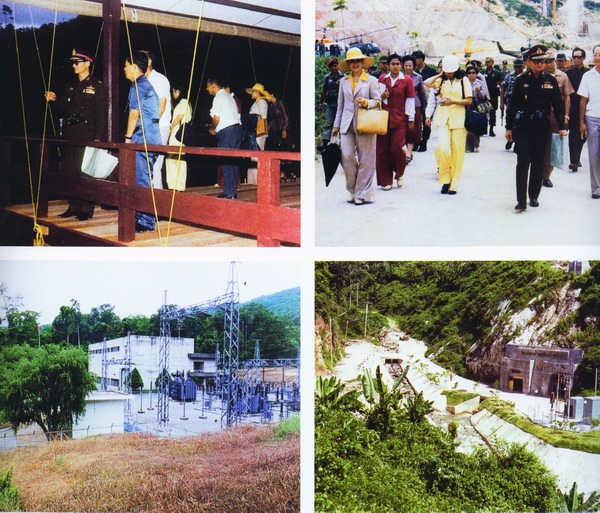
โรงไฟฟ้าพลังน้ำบ้านยาง จังหวัดเชียงใหม่
เป็นโรงไฟฟ้าอีกแห่งหนึ่งซึ่งแสดงให้เห็นถึงพระราชอัจฉริยภาพของพระบาทสมเด็จพระเจ้าอยู่หัวด้านการนำพลังงานน้ำมาผลิตกระแสไฟฟ้าได้อย่างเป็นอย่างดี พลอากาศตรีกำธน สินธวานนท์ องคมนตรี เล่าว่า
"พระองค์ท่านทรงมีความรู้ว่าการผลิตไฟฟ้าจากพลังน้ำสามารถทำได้สองแบบ แบบแรกได้จากการที่น้ำไหลจากที่สูงลงมาพัดกังหันเครื่องกำเนิดไฟฟ้า ส่วนอีกแบบหนึ่งคือ น้ำไหลในทางราบ ซึ่งหากไหลอยู่ตลอดเวลาก็ทำให้กังหันเครื่องกำเนิดไฟฟ้าหมุนได้เช่นกัน เมื่อพระองค์ทอดพระเนตรเห็นทางน้ำไหลอยู่ตลอดเวลาที่บ้านยาง จึงทรงมีพระราชดำริให้ศึกษาถึงความเป็นไปได้ในการสร้างไฟฟ้าที่นี่ ทรงมีพระราชประสงค์ให้ผลิตไฟฟ้าเพื่อนำไปใช้ในการดำเนินงานของโรงงานแปรรูปผลไม้ เพราะเวลานั้นยังไม่มีไฟฟ้าเข้าถึงหมู่บ้านดังกล่าว"
การไฟฟ้าฝ่ายผลิตแห่งประเทศจึงก่อสร้างโรงไฟฟ้าพลังน้ำบ้านยางในเดือนกรกฎาคม พ.ศ. ๒๕๑๖ เมื่อแล้วเสร็จพระบาทสมเด็จพระเจ้าอยู่หัวเสด็จพระราชดำเนินไปทรงเปิดโรงไฟฟ้าในเดือนกุมภาพันธ์ พ.ศ.๒๕๑๗
โรงไฟฟ้าบ้านยางสามารถผลิตกระแสไฟฟ้าได้ประมาณ ๐.๔ ล้านกิโลวัตต์ต่อชั่วโมง นอกจากช่วยให้โรงงานแปรรูปผลไม้สามารถดำเนินงานได้แล้ว ยังช่วยจ่ายกระแสไฟฟ้าให้แก่หมู่บ้านยางและหมู่บ้านใกล้เคียงอีกด้วย
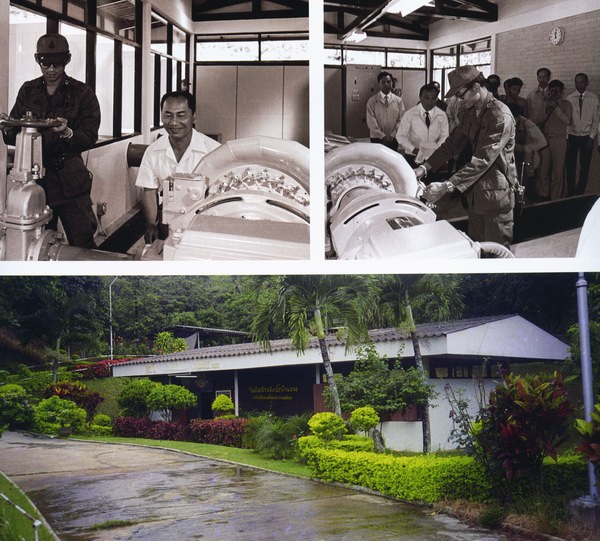
โรงไฟฟ้าพลังน้ำบ้านขุนกลาง จังหวัดเชียงใหม่
เป็นโรงไฟฟ้าสร้างขึ้นตามแนวพระราชดำริของพระบาทสมเด็จพระเจ้าอยู่หัว ด้วยทรงมีพระราชดำริให้การไฟฟ้าฝ่ายผลิตแห่งประเทศไทยศึกษาและพัฒนาพลังน้ำของน้ำตกสิริภูมิ ซึ่งอยู่บนดอยอินทนนท์ในเขตหมู่บ้านขุนกลาง มาใช้ในการผลิตกระแสไฟฟ้าเพื่อส่งให้กับหมู่บ้านชาวไทยภูเขาและพื้นที่การเกษตรของโครงการหลวงบริเวณพื้นที่อุทยานแห่งชาติดอยอินทนนท์
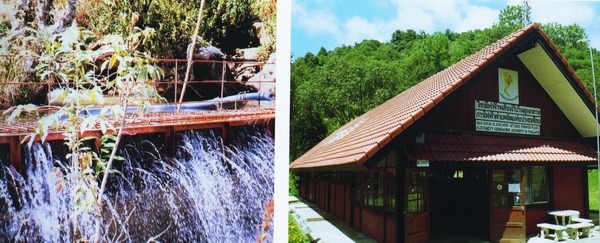
โรงไฟฟ้าพลังน้ำเขื่อนแม่งัดสมบูรณ์ชล จังหวัดเชียงใหม่
โรงไฟฟ้าพลังน้ำเขื่อนแม่งัดสมบูรณ์ชล เดิมเป็นฝายกั้นน้ำขนาดเล็ก ปิดกั้นลำน้ำแม่งัด ในพื้นที่ตำบลช่อแล อำเภอแม่แตง จังหวัดเชียงใหม่ จนกระทั่งในปี พ.ศ.๒๕๑๖ ได้เกิดอุทกภัยขึ้น ทำให้ฝายได้รับความเสียหายจนใช้การไม่ได้กรมชลประทานจึงได้พิจารณาดำเนินการซ่อมแซมฝาย
ต่อมาเมื่อวันที่ ๒๑ มกราคม พ.ศ.๒๕๒๐ พระบาทสมเด็จพระเจ้าอยู่หัวและสมเด็จพระนางเจ้าฯ พระบรมราชินีนาถได้เสด็จพระราชดำเนินเยี่ยมโครงการดังกล่าว และทรงมีพระราชดำริว่า "โครงการประเภทไหนถ้าพิจารณาดูแล้วเห็นว่าสามารถอำนวยประโยชน์ได้มากกว่า ก็สมควรจะเลือกสร้างโครงการประเภทนั้น" กรมชลประทานและการไฟฟ้าฝ่ายผลิตแห่งประเทศไทยจึงได้ร่วมมือกันก่อสร้างโรงไฟฟ้าพลังน้ำเขื่อนแม่งัดสมบูรณ์ชลในปี พ.ศ.๒๕๒๐ โดยกรมชลประทานดำเนินการสร้างเขื่อน และการไฟฟ้าฝ่ายผลิตแห่งประเทศไทยดูแลเรื่องโรงไฟฟ้า แล้วเสร็จในปี พ.ศ.๒๕๒๘ ตัวเขื่อนมีลักษณะเป็นเขื่อนดินถมสูง ๕๙ เมตร ยาว ๑,๙๕๐ เมตร อ่างเก็บน้ำมีความจุ ๒๖๕ ล้านลูกบาศก์เมตร สามารถส่งน้ำ ให้พื้นที่เพาะปลูกได้ ๑๘๘,๐๐๐ ไร่
การไฟฟ้าฝ่ายผลิตแห่งประเทศไทย ได้ก่อสร้างโรงไฟฟ้าพลังน้ำและติดเครื่องกำเนิดไฟฟ้าขนาด ๔,๕๐๐ กิโลวัตต์ จำนวน ๒ เครื่อง รวม ๙,๐๐๐ กิโลวัตต์ สามารถผลิตกระแสไฟฟ้าได้ปีละประมาณ ๒๙ ล้านกิโลวัตต์ต่อชั่วโมง พระบาทสมเด็จพระเจ้าอยู่หัวทรงพระกรุณาโปรดเกล้าฯพระราชทานนามว่า "เขื่อนแม่งัดสมบูรณ์ชล" เมื่อวันที่ ๑๖ กุมภาพันธ์ พ.ศ.๒๕๒๙ และเสด็จพระราชดำเนินไปทรงประกอบพิธีเปิดเขื่อนเมื่อวันที่ ๒๒ กุมภาพันธ์ พ.ศ.๒๕๒๙
เขื่อนพรมธารา จังหวัดชัยภูมิ
เมื่อพระบาทสมเด็จพระเจ้าอยู่หัวเสด็จพระราชดำเนินไปทอดพระเนตรการก่อสร้างเขื่อนจุฬาภรณ์ ทรงมีพระราชดำริว่า ลำห้วยซึ่งเป็นสาขาของแม่น้ำพรมเหนือเขื่อนจุฬาภรณ์เป็นลำห้วยขนาดใหญ่ มีน้ำไหลตลอดปี สมควรศึกษารายละเอียดเพื่อพิจารณาก่อสร้างเขื่อนหรือฝายขนาดเล็กและเจาะอุโมงค์ผันน้ำลงมายังเขื่อนจุฬาภรณ์ การไฟฟ้าฝ่ายผลิตแห่งประเทศไทยจึงทำการศึกษาและก่อสร้างเขื่อนพรมธาราขึ้น ทำให้สามารถผันน้ำมาลงเขื่อนจุฬาภรณ์ได้ถึงปีละ ๒ ล้านลูกบาศก์เมตรส่งผลให้เขื่อนจุฬาภรณ์สามารถผลิตกระแสไฟฟ้าได้เพิ่มขึ้นอีกปีละประมาณ ๒ ล้านกิโลวัตต์ต่อชั่วโมง
เขื่อนพรมธาราจึงแสดงให้เห็นถึงพระราชอัจฉริยภาพในการประดิษฐ์ คิดค้น ดัดแปลงสิ่งที่มีอยู่เพื่อให้ใช้ประโยชน์ได้สูงสุด
โรงไฟฟ้าพลังน้ำเขื่อนห้วยกุ่ม จังหวัดชัยภูมิ
เมื่อพระบาทสมเด็จพระเจ้าอยู่หัวเสด็จพระราชดำเนินเปิดเขื่อนจุฬาภรณ์ ทรงมีพระราชดำริให้การไฟฟ้าฝ่ายผลิตแห่งประเทศไทยศึกษาถึงความเป็นไปได้ในการสร้างเขื่อนอีกแห่งบริเวณใต้เขื่อนจุฬาภรณ์ห่างออกไปประมาณ ๔๐ กิโลเมตร เพื่อแก้ไขปัญหาการขาดแคลนน้ำของเกษตรกร พลอากาศตรีกำธน สินธวานนท์ องคมนตรี เล่าถึงการเสด็จพระราชดำเนินในครั้งนั้นว่า
"พอกราบบังคมทูลว่าเป็นพระมหากรุณาธิคุณล้นเกล้าล้นกระหม่อม ที่เสด็จมาเปิดเขื่อนเล็ก ๆ พระองค์ท่านก็ทรงมีรับสั่งว่า 'นี่คือเขื่อนที่ใหญ่ที่สุดของฉันแล้ว' "
เขื่อนห้วยกุ่มนอกจากช่วยบรรเทาความเดือดร้อนของเกษตรกรบริเวณลำน้ำพรมตอนล่าง ครอบคลุมพื้นที่เกษตรกรรมประมาณ ๘๐,๐๐๐ ไร่แล้ว ยังเป็นเขื่อนที่สามารถผลิตกระแสไฟฟ้าได้ปีละประมาณ ๑๓,๐๐๐ กิโลวัตต์ต่อชั่วโมงอีกด้วย เป็นอีกโครงการพระราชดำริที่ทรงคำนึงถึงความเดือดร้อนของประชาชนเป็นสำคัญ ในขณะเดียวกันก็เป็นตัวอย่างของการใช้ทรัพยากรเพื่อให้ได้ประโยชน์สูงสุด
โรงไฟฟ้าพลังน้ำคลองช่องกล่ำ จังหวัดสระแก้ว
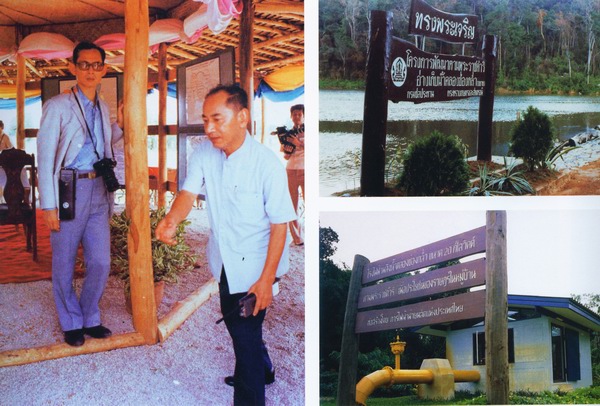
เดิมบริเวณดังกล่าวซึ่งเป็นพื้นที่ป่าเชิงเขาบรรทัดแถบชายแดนไทย-กัมพูชา จังหวัดสระแก้ว มีสภาพป่าเสื่อมโทรมถูกบุกรุกทำลาย ราษฎรประสบปัญหาขาดแคลนน้ำในการทำการเกษตร และในเวลานั้นยังเป็นพื้นที่ที่มีการสู้รบกับผู้ก่อการร้ายอีกด้วย พระบาทสมเด็จพระเจ้าอยู่หัวทรงมีพระราชดำริให้ก่อสร้างเขื่อนช่องกล่ำตอนบน เขื่อนช่องกล่ำตอนล่าง และเขื่อนท่ากระบาก โดยแล้วเสร็จในปี พ.ศ.๒๕๒๔
เมื่อวันที่ ๒ กรกฎาคม พ.ศ.๒๕๒๔ พระบาทสมเด็จพระเจ้าอยู่หัวเสด็จพระราชดำเนินเยี่ยมเยียนราษฎรในพื้นที่ ทรงมีพระราชดำริให้พิจารณานำน้ำที่ระบายจากเขื่อนมาใช้ประโยชน์ในการผลิตกระแสไฟฟ้าก่อนระบายน้ำไปใช้ในการเกษตรและทรงมีพระราชดำริให้เพิ่มความสูงของเขื่อนคลองช่องกล่ำตอนบนอีก ๒ เมตร หรือตามความเหมาะสม เพื่อให้อ่างเก็บน้ำมีความจุมากขึ้นและสามารถเพิ่มกำลังผลิตกระแสไฟฟ้าได้มากขึ้นตามไปด้วย
การไฟฟ้าฝ่ายผลิตแห่งประเทศไทยจึงพัฒนาสร้างเป็นโรงไฟฟ้าพลังน้ำคลองช่องกล่ำตอนบนที่ตำบลหนองน้ำใส อำเภอวัฒนานคร จังหวัดสระแก้ว เพื่อผลิตกระแสไฟฟ้าใช้กับเครื่องสีข้าวและไฟฟ้าแสงสว่างสาธารณะในหมู่บ้าน ๓ แห่ง คือ คลองทราย คลองคันโท และท่ากระบาก ของจังหวัดสระแก้ว
โรงไฟฟ้าพลังน้ำไอกะเปาะ จังหวัดนราธิวาส
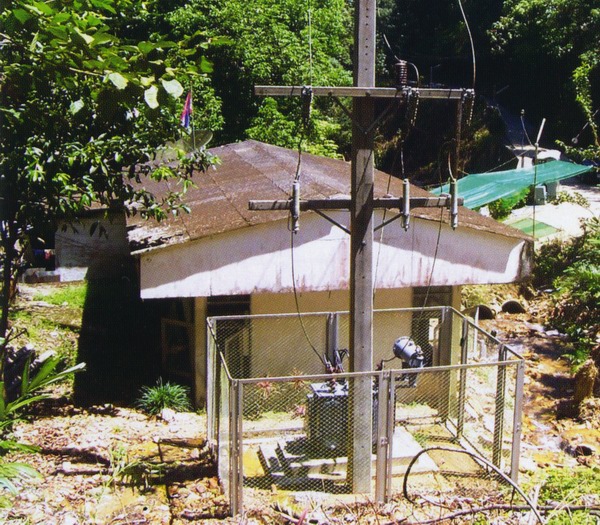
เมื่อพระบาทสมเด็จพระเจ้าอยู่หัวเสด็จพระราชดำเนินไปทรงเยี่ยมเยียนสมาชิกนิคมพัฒนาภาคใต้ ณ สำนักสงฆ์โต๊ะโมะ อำเภอสุคิริน จังหวัดนราธิวาส หลังจากทอดพระเนตรนาขั้นบันได นาข้าวไร่ บริเวณหมู่บ้านภูเขาทอง และการทดลองปลูกข้าวที่โครงการฝายทดน้ำโต๊ะโมะแล้ว พระองค์ท่านทรงมีพระราชดำเกี่ยวกับการชลประทานและงานต่าง ๆ ทรงแนะให้พิจารณาวางโครงการและก่อสร้างฝายเก็บน้ำไอกะเปาะพร้อมกับโรงไฟฟ้าพลังน้ำ เพื่อนำไฟฟ้าเป็นเชื้อเพลิงให้กับเครื่องสีข้าวขนาด ๒๕ กิโลวัตต์ ที่ราษฎรน้อมเกล้าน้อมกระหม่อมถวายสำหรับติดตั้งบริเวณสำนักสงฆ์ต่อไป นอกจากนั้น กำลังไฟฟ้าส่วนที่เหลือสามารถนำไปใช้ในหมู่บ้านบริเวณใกล้เคียง อันได้แก่ หมู่บ้านไอกะเปาะ หมู่บ้านโต๊ะโมะ และหมู่บ้านลำธารทองได้อีกด้วย
หลังจากศึกษาความเป็นไปได้ กรมพัฒนาพลังงานทดแทนและอนุรักษ์พลังงาน กระทรวงพลังงาน (สำนักงานพลังงานแห่งชาติในเวลานั้น) จึงเริ่มก่อสร้างฝายเก็บน้ำไอกะเปาะและโรงไฟฟ้าพลังน้ำตั้งแต่เดือนมกราคม พ.ศ.๒๕๒๖ และแล้วเสร็จในเดือน กันยายน พ.ศ.๒๕๒๗
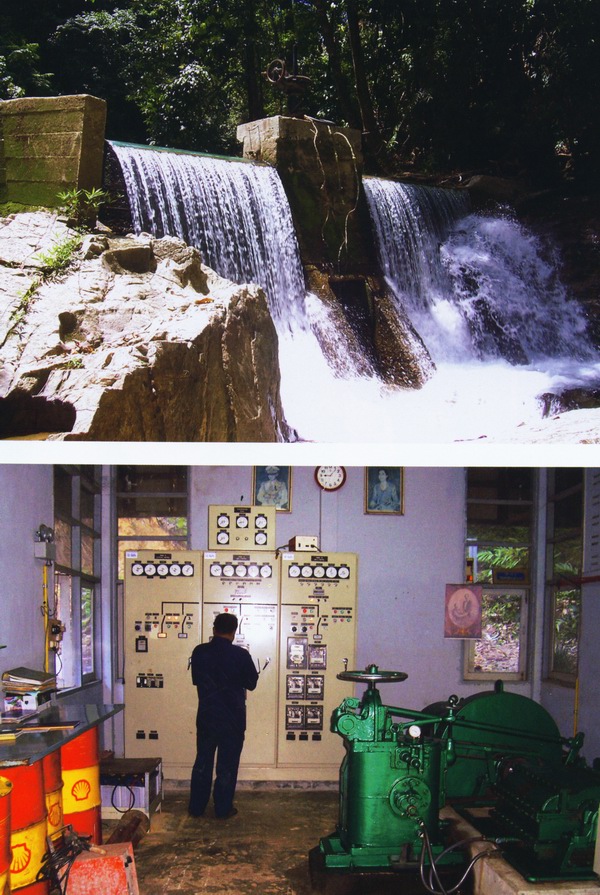
โรงไฟฟ้าพลังน้ำคลองทุ่งเพล จังหวัดจันทบุรี
เมื่อปี พ.ศ.๒๕๒๙ พระบาทสมเด็จพระเจ้าอยู่หัวเสด็จพระราชดำเนินเปิดเขื่อนคิรีธาร อำเภอมะขาม จังหวัดจันทบุรี เดิมชื่อโครงการห้วยสะพานหิน ซึ่งเป็นเขื่อนขนาดกลางของกรมพัฒนาพลังงานทดแทนและอนุรักษ์พลังงาน คุณสิริพร ไศละสูต อดีตอธิบดีกรมพัฒนาพลังงานทดแทนและอนุรักษ์พลังงาน เล่าถึงการถวายรายงานในครั้งนั้นว่า
"เมื่อถวายรายงานว่า หลังจากนี้กรมจะสร้างฝายยางเพื่อกั้นน้ำและปล่อยน้ำไปช่วยทางจังหวัดตราดพระองค์รับสั่งว่า "ยังไม่วิกฤติ ยังน้อย คนที่ต้องช่วยเขาก่อนจะอยู่ทางด้านทุ่งเพล เพราะขาดน้ำมากกว่า"...
สิ่งที่พระองค์ท่านรับสั่งเป็นเรื่องที่เราคาดไม่ถึง ในสายพระเนตรของพระเจ้าอยู่หัว ทุกคนคือราษฎร พระองค์ท่านไม่ได้โปรดใครเป็นพิเศษเป็นการเฉพาะ แต่ทรงมองถึงเหตุและความจำเป็น ในขณะที่เราเห็นว่าการสร้างฝายแห่งหนึ่งดีกว่า พระองค์ท่านไม่ได้รับสั่งให้เราหยุดทำ แต่รับสั่งให้ไปพิจารณาว่าควรทำอีกแห่งหนึ่งด้วย...
พระราชดำริของพระเจ้าอยู่หัวไม่ได้หมายความว่าพระองค์ท่านรับสั่งให้ไปทำ แต่เหมือนพระองค์ท่านพระราชทานคำแนะนำ และทรงกระตุ้นผู้ปฏิบัติงานให้ทบทวนว่าทำงานละเอียดรอบคอบแล้วหรือไม่ การที่พระองค์ท่านทรงมีแนวพระราชดำริ ผู้นำไปปฏิบัติต้องคิดพิจารณาต่อด้วย ถ้าศึกษาแล้วไม่คุ้ม ทำไม่ได้ พระองค์ก็ไม่ทรงว่าอะไร เท่าที่เคยรับพระราชดำริมา ยังไม่มีพระราชดำริใดที่ทำไม่ได้หรือทำแล้วไม่คุ้ม"
ปัจจุบันโครงการโรงไฟฟ้าพลังน้ำคลองทุ่งเพล ซึ่งเป็นโครงการอันเนื่องมาจากพระราชดำริ กำลังก่อสร้าง อยู่ในเขตกิ่งอำเภอเขาคิชฌกูฏ และอำเภอมะขาม จังหวัดจันทบุรี มีขนาดกำลังผลิตรวม ๙.๘ เมกะวัตต์ เมื่อแล้วเสร็จสามารถผลิตพลังงานไฟฟ้าได้ปีละ ๒๘.๑๖ ล้านกิโลวัตต์ต่อชั่วโมง
"เรียกได้ว่าพระบาทสมเด็จพระเจ้าอยู่หัวทรงเป็นเอตทัคคะทางด้านน้ำและฝน ทุกวันนี้แทนที่หน่วยงานราชการจะถวายรายงานพระองค์ท่าน แต่กลายเป็นพระองค์ท่านมีพระราชดำริและพระราชทานคำแนะนำแก่หน่วยงานราชการต่าง ๆ"
ดร.บุญรอด บิณฑสันต์ ผู้ก่อตั้งและอดีตเลขาธิการการพลังงานแห่งชาติ
"...พระองค์ท่านทรงห่วงใยประชาชนที่ยากลำบาก เช่น ชาวเขา ชาวบ้านในชนบท ที่ยังขาดปัจจัยด้านน้ำและไฟฟ้า ทรงมีพระราชดำริให้มีการสร้างฝายเล็ก ๆ ขึ้น เพราะ "น้ำ"เป็นปัจจัยที่จำเป็นด้านอุปโภคบริโภค "ไฟฟ้า"เองก็มีใช้กันในเมือง แต่ชนบทยังขาดแคลน ทรงเห็นว่าน่าจะใช้น้ำไปเดินเครื่องกำเนิดไฟฟ้าเล็ก ๆ เพื่อให้ชาวบ้านในชนบท ได้มีไฟฟ้าใช้ กฟผ.นำแนวพระราชดำริมาพัฒนาจัดทำเป็นโรงไฟฟ้าพลังน้ำขนาดเล็ก ๆ อันเนื่องมาจากพระราชดำริ...
พระองค์ทรงดูแลทุกข์สุขของประชาชนที่ขาดปัจจัยพื้นฐาน โดยเฉพาะเรื่องน้ำ ในยามปกติจะทรงขอทราบข้อมูลเรื่องน้ำในเขื่อนเป็นประจำ ดูเรื่องน้ำที่จะใช้อุปโภคบริโภค รวมถึงในยามที่ประชาชนได้รับความเดือดร้อนจากอุทกภัยก็มีโครงการตามพระราชดำริต่าง ๆ เช่น โครงการแก้มลิง ช่วยบรรเทาความเดือดร้อน...
จะเห็นได้ว่าพระองค์ท่านทรงห่วงใยแลดูแลทุกข์สุขของประชาชน ซึ่งกฟผ.ได้น้อมนำแนวทางของพระองค์ท่านมาใช้ในการดำเนินงานเพื่อสร้างความผาสุกให้กับประชาชน และ กฟผ. เองก็ได้ร่วมให้การช่วยเหลือประชาชนที่เดือดร้อนทุกครั้ง หรือในยามปกติ กฟผ. ก็จะดูแลช่วยเหลือสังคมในด้านต่าง ๆ เช่น การศึกษา ศาสนา สาธารณสุข อยู่เป็นประจำ"
คุณไกรสีห์ กรรณสูต ผู้ว่าการการไฟฟ้าฝ่ายผลิตแห่งประเทศไทย
ที่มา : พระบิดาแห่งการพัฒนาพลังงานไทย
การพัฒนาพลังงานทดแทน
การพัฒนาพลังงานทดแทน
"ประมาณปี พ.ศ.๒๕๒๔ เกิดการเปลี่ยนแปลงการปกครองในอิหร่าน มีการสู้รบกัน น้ำมันขาดแคลนและราคาพุ่งสูงมาก ประเทศไทยตอนนั้นยังพึ่งพาน้ำมันยิ่งกว่าตอนนี้อีก ก๊าซธรรมชาติก็ยังไม่ได้ขุดขึ้นมาใช้ ช่วงนั้นลำบากมากเรื่องราคาน้ำมัน...
จำได้ว่าเริ่มมีข่าวโครงการพระราชดำริแล้ว ในขณะที่รัฐบาลยังไม่คิดกันเลย เพราะคิดแต่ว่าราคาน้ำมันเปลี่ยนแปลงเพราะการเมือง ทุกคนคิดว่าเดี๋ยวเลิกรบราคาก็ถูกลงเอง ปี ๒๕๒๘-๒๕๒๙ ราคาถูกลง ทุกคนก็สบายใจว่าคงไม่มีปัญหาอะไร ตอนนั้นก็โครงการพระราชดำริเรื่องเอทานอลและ ไบโอดีเซลก็มีการวิจัยทดลองเรื่อยมาจนถึงปัจจุบัน รัฐบาลเพิ่งจะมามองเรื่องนี้ช่วงปี ๒๕๔๐ ถ้าจำไม่ผิดเป็นเรื่องของพืชผลการเกษตรราคาตกต่ำ น้ำมันมะพร้าว น้ำมันปาล์มขายไม่ออก ถึงได้เริ่มหันมามองว่าเอามาเป็นน้ำมันเชื้อเพลิงได้ไหน...
"ประมาณปีพ.ศ. ๒๕๒๔ เกิดการเปลี่ยนแปลงการปกครองในอิหร่าน มีการสู้รบกัน น้ำมันขาดแคลนและราคาพุ่งสูงมาก ประเทศไทยตอนนั้นยังพึ่งพาน้ำมันยิ่งกว่าตอนนี้อีก ก๊าซธรรมชาติก็ยังไม่ได้ขุดขึ้นมาใช้ ช่วงนั้นเราลำบากมากเนื่องน้ำมัน"
เรื่องเอทานอล มีนักวิชาการบางท่านเริ่มทำ แต่สิ่งที่พวกเราเห็นกันต่อเนื่องมาตลอดคือ โครงการพระราชดำริมีการพัฒนาไม่เคยหยุดหย่อน พัฒนาต่อเนื่อง ต้องถือว่าผลลัพธ์ที่ได้จากโครงการพระราชดำริคือองค์ความรู้แห่งเดียวของเมืองไทยที่มีอย่างต่อเนื่อง พัฒนาจากสิ่งที่เรามีอยู่ จากวัสดุในเมืองไทย และนำมาใช้กับรถยนต์ในเมืองไทย ไม่ใช่ จากตำราต่างประเทศ...
นอกจากนั้นเมื่อรัฐบาลเริ่มพัฒนาโครงการนี้อย่างจริงจัง คนไทยก็เชื่อว่ามันทำได้ เพราะโครงการส่วนพระองค์ทดลองใช้มานานแล้ว ผมว่ารัฐบาลได้ประโยชน์เต็มๆ เพราะเมื่อถึงเวลาที่ตนเองมาส่งเสริม ไม่ต้องพูดมาก กระแสยอมรับมีอยู่แล้ว ประเทศเพื่อนบ้านเรายังติดขัดกันอยู่เลย เพราะประชาชนไม่เชื่อว่าใช้แล้วรถไม่พัง การที่เรามีองค์ความรู้ต่อเนื่องกันมามีส่วนส่งเสริมกับภาวการณ์ที่เกิดขึ้นจริงในปัจจุบัน...
ถ้าเราไม่ได้มีพื้นฐานทีได้ศึกษากันไว้เลย ต้องช้ากว่านี้แน่นอน ถ้าเราไม่รู้จักแก๊สโซฮอล์หรือไบโอดีเซลเลย ไม่เคยมีในประเทศไทยมาก่อน มาเริ่มต้นกันใหม่ มันก็ต้องไปเริ่มจากพืช ว่าจะเอาพืชอะไรมาผลิตแอลกอฮอล์ แล้วคุณสมบัติควรจะต้องเป็นอย่างไร เติมเครื่องยนต์แล้วมีผลเสียอะไรหรือไม่ สิ่งเหล่านี้ต้องมีประสบการณ์จริงเท่านั้น จึงจะนำไปยืนยันกับผู้คนได้ อันนี้ชัดเจนว่าองค์ความรู้ที่รัฐบาลนำมาใช้เป็นพื้นฐานคือองค์ความรู้จากประสบการณ์ที่เป็นผลมาจากโครงการพระราชดำริทั้งนั้น แถมเมื่อเริ่มต้นออกสู่ตลาด อาจพูดได้ว่าเหมือนน้ำมันพระราชทาน เพราะน้ำมันที่ผสม ๑๐ เปอร์เซ็นต์ ๕ เปอร์เซ็นต์ มีแหล่งเดียวที่ผลิตในประเทศไทย คือขอรับไปจากโครงการพระราชดำรินี่ละครับ"
ดร.ส่งเกียรติ ทานสัมฤทธิ์ เสริมว่า
"เราจะพบว่าพระองค์ท่านทรงทำการวิจัยค้นคว้ามาโดยตลอด บางช่วงราคาน้ำมันลงไป พระองค์ท่านก็ไม่ได้หยุดยั้งยังทรงให้ดำเนินการอย่างต่อเนื่อง มีการสร้างโรงงานขึ้นในสวนจิตรลดา เชื่อหรือไม่ เมื่อประเทศเผชิญวิกฤติราคาน้ำมันครั้งที่ ๓ ปั๊มในสวนจิตรลดาเป็นปั๊มแรกที่นำเอทานอลมาผสมและจำหน่ายบรรเทาความเดือดร้อนของประชาชน หลังจากนั้นจึงเป็นภาคเอกชนค่อยๆเกิดตามมา ผมจึงเรียนว่าจะไม่ประทับใจต่อพระราชกรณียกิจของพระองค์ท่านได้อย่างไร"
" องค์ความรู้ที่รัฐบาลนำมาใช้เป็นพื้นฐานคือองค์ความรู้จากประสบการณ์ที่เป็นผลมาจากโครงการพระราชดำริทั้งนั้น "
การดำเนินการพัฒนาพลังงานเพื่อสนองแนวพระราชดำริ
เอทานอล
นโยบายเกี่ยวกับแก๊สโซฮอล์ของกระทรวงพลังงานเริ่มในปี พ.ศ.๒๕๔๖ คณะรัฐมนตรีเห็นชอบให้ปี พ.ศ.๒๕๔๗ - ๒๕๔๗ ทดลองใช้เอทานอลสาร MTBE ในน้ำมันเบนซิน ออกเทน ๙๕ โดยกำหนดให้ปี พ.ศ. ๒๕๕๔ จะใช้แอลกอฮอล์ ๓ ล้านลิตรต่อวัน สำหรับการผสมในอัตราส่วนร้อยละ ๑๐ ในแก๊สโซฮอล์ ๙๕ และ ๙๑
สำหรับบริษัท ปตท. จำกัด (มหาชน) ในฐานะบริษัทน้ำมันที่ดำเนินการสนองแนวพระราชดำริเรื่องแก๊สโซฮอลล์ ดร.ส่งเกียรติอธิบายว่า "เราประสานงานกับภาครัฐบาลมาตลอด โดยเฉพาะเรื่องการจัดหาเอทานอล ปตท. เริ่มจำหน่ายแก๊สโซฮอล์แห่งแรกที่สถานีบริการของ ปตท. สำนักงานใหญ่ เมื่อวันที่ ๑๑ มกราคม พ.ศ.๒๕๔๔ ปัจจุบันใน พ.ศ. ๒๕๔๙ ปตท. มีสถานีบริการน้ำมันแก๊สโซฮอล์มากที่สุด จำนวน ๑,๑๙๗ สถานีปริมาณจำหน่ายแก๊สโซฮอล์ทั้ง ๙๑ และ ๙๕ รวมกันประมาณ ๓.๗ ล้านลิตรต่อวัน"
ไบโอดีเซล
คณะรัฐมนตรีกำหนดให้ปี พ.ศ. ๒๕๔๗ - ๒๕๔๘ มีการทดลองตลาดไบโอดีเซล B2 และ B5 ปัจจุบันมีความต้องการใช้ไบโอดีเซล B5 รวมวันละ ๕๐๐,๐๐๐ ลิตร บริษัท ปตท. จำกัด (มหาชน) จัดหาเมทิล เอสเตอร์ B100 จากผู้ผลิตรายย่อยในปริมาณวันละ ๑๖,๖๐๐ ลิตร นำมาผสมได้ไบโอดีเซล B5 วันละ ๓๐๐,๐๐๐ ลิตร
และในปี พ.ศ.๒๕๕๐ บริษัท ปตท. จำกัด (มหาชน) จะสามารถจัดหาเมทิล เอสเตอร์ B100 จากโรงงานบริษัท ไทยโอลีโอเคมี จำกัด (TOL) ที่มีกำลังผลิตเมทิล เอสเตอร์ B100 ๒๐๐,๐๐๐ ตันต่อปี หรือประมาณวันละ ๖๐๐,๐๐๐ ลิตร ซึ่งสามารถนำไปผลิตไบโอดีเซล B5 ได้วันละ ๑๒ ล้านลิตรและเมื่อรวมกับกำลังผลิตของบริษัท ทักษิณปาล์ม จำกัด และบริษัท ไบโอเอ็นเนอยี่พลัส จำกัด จะทำให้สามารถผลิตไบโอดีเซล B5 ได้วันละ ๒๒ ล้านลิตร ปัจจุบันบริษัท ปตท. จำกัด (มหาชน) มีการจำหน่ายดีเซลทั้งหมดประมาณวันละ ๑๖ ล้านลิตร
"และในปีพ.ศ. ๒๕๕๐ บริษัท ปตท. จำกัด (มหาชน) จะสามารถจัดหาเมทิล เอสเตอร์ B100 จากโรงงานบริษัท ไทยโอลีโอเคมี จำกัด (TOL) ที่มีกำลังผลิตเมทิลเอสเตอร์ B100 ๒๐๐,๐๐๐ ตันต่อปี หรือประมาณวันละ ๖๐๐,๐๐๐ ลิตร ซึ่งสามารถนำไปผลิตไบโอดีเซล B5 ได้วันละ ๑๒ ล้านลิตร"
ส่วนไบโอดีเซลจะมีปัญหาเรื่องปริมาณวัตถุดิบที่จะนำมาผลิตไบโอดีเซลเหมือนกับเอทานอลหรือไม่ คุณเมตตาระบุว่า
"เรามีบทเรียนจากเอทานอล คงไม่เกิดกรณีอย่างนั้นอีก มันเป็นเรื่องของการจัดการสองด้าน ขณะที่เราส่งเสริมการปลูกพืช ให้มีโรงงานเกิดขึ้นมา เราก็ต้องไปจัดการด้านการจำหน่าย เตรียมหาผู้จำหน่ายรองรับไว้ด้วย ภาครัฐต้องบริหารให้เท่ากัน...
ช่วงแรกๆ การบริหารจัดหาให้มีโรงงานผลิตออกมา ในขณะที่ภาคจำหน่ายยังรองรับไม่หมด ก็มีเสียงบ่นโวยวายมาจากโรงงานว่ารัฐบาลไม่จริงใจ พอเราส่งเสริมด้านการจำหน่าย กลายเป็นว่าความต้องการมากกว่ากำลังผลิต ทำให้ราคาสูงขึ้น ก็มีเสียงบ่นว่าโรงงานถือโอกาส นั่นเป็นบทเรียนที่ได้จากแก๊สโซฮอล์ ไบโอดีเซลก็คงมีปัญหาบ้าง แต่คงน้อยกว่า เพราะเรารู้แล้วว่าต้องทำอย่างไร"
สำหรับกรณีปัญหาเรื่องการนำพืชอาหารมาทำเป็นเชื่อเพลิงส่งผลกระทบต่อปริมาณอาหารหรือไม่ คุณเมตตาอธิบายว่า
"ผมเชื่อว่าถ้าพืชถูกนำมาใช้เป็นเชื้อเพลิงจริงๆ มันจะเกิดจากแยกตัวของการปลูกจะไม่เกี่ยวกัน สังเกตจากตอนนี้ อ้อย น้ำตาลในสหรัฐฯ ในบราซิล ชนิดนำมาบริโภคกับนำมาใช้เป็นเชื้อเพลิงก็ไม่เหมือนกัน ผมเชื่อว่าอย่างปาล์มก็คงไม่เหมือนกัน น้ำมันปาล์มที่เราใช้บริโภคคุณภาพดีเกินไป ควรหาปาล์มต้นทุนต่ำกว่านี้ ทำให้ถูกที่สุด...
ทางเลือกในการบริโภคอาหารมีหลากหลาย แต่ทางเลือกของเชื้อเพลิงมันจำกัดกว่า ผมว่าต้องเผื่อแผ่กันทั้งสองฝ่าย ฝ่ายที่มองว่ามันเป็นอาหารก็ต้องนึกว่าจำเป็นต้องเอาไปแทนที่เชื้อเพลิงบางส่วนก็ต้องเอาไป ส่วนผู้บริโภคอาหารก็หาอย่างอื่นทดแทนไป อาหารนี่ทางเลือกสูงมาก ไม่อย่างนั้นประเทศผู้ผลิตอาหารไม่เสียเปรียบอย่างทุกวันนี้ ไม่เคยมีอำนาจต่อรองเหนือใครเลย เพราะว่าผู้ซื้อมีทางเลือกมหาศาล อาจมีการกระทบกระทั่งกันบ้างในช่วงแรก แต่ผมเชื่อว่าเมื่อถึงจุดหนึ่งมันจะแยกตัวกัน"
บริษัท ปตท. จำกัด (มหาชน) ซึ่งมีส่วนร่วมในการพัฒนามาตรฐานและทดสอบคุณภาพของไบโอดีเซลกับภาครัฐมาโดยตลอด และกำลังดำเนินการก่อสร้างโรงงานต้นแบบของตนเองที่ศูนย์วิจัยและพัฒนา เพื่อพัฒนาเทคโนโลยีการผลิตไบโอดีเซลให้มีประสิทธิภาพทัดเทียมกับต่างประเทศ
ส่วนการพัฒนาพลังงานทดแทนในอนาคตมีทิศทางเป็นอย่างไรนั้นในฐานะบริษัทผู้ผลิตน้ำมัน ดร.ส่งเกียรติสรุปว่า
"ผมเรียกว่าอีก ๑๐๐ ปีข้างหน้า น้ำมันก็ยังมีอยู่ แต่จะเป็นน้ำมันที่ไม่ใช่น้ำมันที่ผลิตอยู่ในปัจจุบัน มันจะเป็นน้ำมันจากก๊าซธรรมชาติก็ได้ มีโรงงานที่ผลิตแล้วที่กาตาร์ นำก๊าซธรรมชาติมาเปลี่ยนเป็นน้ำมันดีเซล ที่สะอาดมาก สีใสเหมือนน้ำเลย ถ่านหินก็สามารถนำมาทำเป็นน้ำมันดีเซลได้เช่นกัน แล้วก็ได้ก๊าซธรรมชาติมาด้วย ทาร์แซนด์ (tar sands) ที่แคนาดาซึ่งมีมากมายมหาศาล ก็นำมาทำน้ำมันได้ เซลล์ออยล์ที่จีนแดงไปร่วมลงทุนกับบริษัทในแคนาดาเริ่มผลิตอยู่ ส่วนแหล่งน้ำมันในทะเลต่อไปจะมาจากความลึกระดับน้ำทะเล ๑,๐๐๐ เมตร ถ้าน้ำมันยังราคาสูงต่อไป จะมีแหล่งน้ำมันมาจากที่ลึกมาก เรียกว่าซูเปอร์ดีป คือ ๒,๐๐๐ เมตร หรือถ้าเกิน ๑๐๐ ปีขึ้นไป หาอะไรไม่ได้แล้ว ใต้ทะเลลึกยังมีดีไฮเดรตแก๊ส คือก๊าซมีเทน ซึ่งถูกแรงกดดันของน้ำทะเลและอุณหภูมิของน้ำทะเล ทำให้ก๊าซธรรมชาติเป็นน้ำแข็งอยู่ใต้ทะเลลึก
ถ้านำเอาขึ้นมาเปลี่ยนเป็นน้ำมัน อีก ๑๐๐ ปีข้างหน้า รถยนต์ก็ยังเป็นรถยนต์ที่ใช้น้ำมัน แต่อยู่ที่ราคาจะเป็นเท่าไหร่ ซึ่งอาจจะมีเทคโนโลยีใหม่ๆ เพิ่มขึ้นมา เช่น รถยนต์ไฮบริด รถยนต์ขนาดเล็ก แต่ว่ายังคงใช้น้ำมัน แต่จะเป็นน้ำมันที่เกิดขึ้นหลากหลายรูปแบบ...
ปตท. มองว่าเราต้องศึกษาเรื่องเทคโนโลยีหาทางเรียนรู้วิธีของเราสถาบันวิจัยและเทคโนโลยีของปตท. กำลังจะติดตั้ง fuel cell ที่ศูนย์วิจัยวังน้อย เพื่อผลิตไฮโดรเจน และนำไฮโดรเจนไปผลิตกระแสไฟฟ้าประมาณปีหน้าจะเริ่มทดลองเดินเครื่อง ส่วนเรื่องน้ำมันเราเชื่อว่ายังอยู่ได้อีก ๑๐๐ ปี แต่จะมาจากหลากหลายรูปแบบ ส่วนราคาคงอยากให้น้ำมันราคาอยู่ในระดับ ๒๐ - ๓๐ เหรียญต่อบาร์เรลอีก"
การพัฒนาพลังงานทดแทนอื่นๆ จึงมีความจำเป็นต่อโลกในอนาคตอย่างหลีกเลี่ยงไม่ได้
โครงการตามแนวพระราชดำริ อันเกี่ยวเนื่องกับกิจการพลังงาน
๖๐ ปีที่ทรงครองราชย์ คือ ๖๐ ปีแห่งพระราชกรณียกิจเพื่อประโยชน์สุขของพสกนิกรทั่วแผ่นดิน ด้วยสายพระเนตรอันยาวไกล พระบาทสมเด็จพระเจ้าอยู่หัวทรงวางพื้นฐาน สร้างแนวคิด และศึกษาวิจัยหาวิธีผลิตพลังงานต่างๆ อย่างต่อเนื่องยาวนาน ซึ่งช่วยบรรเทาวิกฤติการณ์พลังงานที่เกิดขึ้นในปัจจุบันอย่างไม่ได้ผลเป็นรูปธรรม
แนวพระราชดำริอันเกี่ยวเนื่องกับการพัฒนาพลังงานนั้นครอบคลุมทุกด้าน อันได้แก่
พลังน้ำ...พลังแห่งน้ำพระราชหฤทัย
พระบาทสมเด็จพระเจ้าอยู่หัวทรงพระปรีชาสามารถในเรื่องเกี่ยวกับ "น้ำ" ยากจะหาผู้ใดเสมอเหมือนแนวพระราชดำริของพระองค์ท่านทรงเน้นการสร้างเขื่อนและโรงไฟฟ้าพลังน้ำขนาดเล็กเพื่อกักเก็บน้ำไว้ใช้ประโยชน์และยังสามารถผลิตกระแสไฟฟ้าให้กับชุมชนในละแวกใกล้เคียงในพื้นที่ชนบทห่างไกล เสริมการทำงานของโครงการไฟฟ้าพลังน้ำขนาดใหญ่ของภาครัฐ
พลังงานชีวภาพ...พลังแห่งพระปรีชาญาณ
ในขณะที่คนทั่วไปมองว่าการนำพืชมาทำเป็นเชื้อเพลิงไม่คุ้มค่า แต่ด้วยสายพรนะเนตรอันยาวไกล พระบาทสมเด็จพระเจ้าอยู่หัวทรงมีกระแสพระราชดำรัสให้โครงการส่วนพระองค์ศึกษาวิจัยการนำพืชมาผลิตเป็นเชื้อเพลิงมานานกว่า ๒๐ ปี ทำให้ประเทศไทยมีทางเลือกมากขึ้นเมื่อต้องเผชิญกับสถานการณ์วิกฤตพลังงานในปัจจุบัน
พลังงานทดแทน...พลังแห่งสายพระเนตร
การพัฒนาพลังงานทดแทนอื่นๆ เช่น พลังงานแสงอาทิตย์ พลังงานลม เชื้อเพลิงอัดแท่ง ระบบผลิตน้ำเย็นโดยใช้พลังงานความร้อนจากแกลบ ล้วนแต่มีตัวอย่างกระจายอยู่ในโครงการส่วนพระองค์สวนจิตรลดา และศูนย์ศึกษาการพัฒนาอันเนื่องมาจากพระราชดำริในภูมิภาคต่างๆ เพื่อปิดโอกาสให้ประชาชนที่สนใจเข้ามาศึกษาและนำไปปรับใช้เหมาะสมกับวิถีชีวิตของตนเอง
ที่มา : พระบิดาแห่งการพัฒนาพลังงานไทย
โครงการฝนหลวง
โครงการฝนหลวง
โครงการฝนหลวงเกิดขึ้นจากพระราชดำริส่วนพระองค์ ในพระบาทสมเด็จพระเจ้าอยู่หัว ในปี พ.ศ.๒๔๙๘ เมื่อคราวเสด็จพระราชดำเนินเยี่ยมพสกนิกรในภาคตะวันออกเฉียงเหนือ ได้ทรงรับทราบถึงความเดือดร้อน ทุกข์ยากของราษฎร และเกษตรกรที่ขาดแคลนน้ำอุปโภคและการเกษตร จึงได้มีพระมหากรุณาธิคุณพระราชทานโครงการพระราชดำริ "ฝนหลวง"ให้กับ ม.ร.ว.เทพฤทธิ์ เทวกุล ไปดำเนินการ ซึ่งต่อมาได้เกิดเป็นโครงการค้นคว้าทดลอง ปฏิบัติการฝนเทียมหรือฝนหลวงขึ้น ในสังกัดสำนักงานปลัดกระทรวงเกษตรและสหกรณ์ เมื่อปี ๒๕๑๒ ด้วยความสำเร็จของโครงการ จึงได้ตราพระราชกฤษฏีกาก่อตั้งสำนักงานปฏิบัติการฝนหลวงขึ้นในปี พ.ศ.๒๕๑๘ ในสังกัดกระทรวงเกษตรและสหกรณ์เพื่อเป็นหน่วยงานรองรับโครงการพระราชดำริ "ฝนหลวง"ต่อไป
สารที่ใช้ทำฝนหลวงในปัจจุบันมีทั้งสิ้น ๗ ชนิด บางชนิดมีคุณสมบัติดูดซับความชื้นได้ดี (hygroscopic substances) บางชนิดมีคุณสมบัติเป็นแกนกลั่นตัว (CCN) ของความชื้นในอากาศ บางชนิดสามารถคายความร้อนออกมาเพื่อกระตุ้น หรือเสริมการก่อตัวและเจริญเติบโตของเมฆ บางชนิดสามารถดูดดึงความร้อนทำให้อุณหภูมิของอากาศหรือเมฆเย็นตัวลง เร่งการกลั่นตัวของไอน้ำและเสริมความหนาแน่นของเมฆจนเกิดเป็นฝน การเลือกใช้สารฝนหลวงแต่ละชนิดจึงพิจารณาคุณสมบัติที่กล่าวข้างต้นกับสภาวะ ของเมฆหรือบรรยากาศในแต่ละวันเป็นสำคัญ สารฝนหลวงที่ใช้แบ่งออกได้เป็น ๓ ประเภท คือ สารฝนหลวงสูตรร้อน สารฝนหลวงสูตรเย็น และสารฝนหลวงสูตรสร้างแกนกลั่นตัวของอากาศ
สำหรับสารฝนหลวงสูตรเย็นนั้นมีคุณสมบัติเมื่อดูดซับความชื้นในอากาศ หรือทำปฏิกิริยากับน้ำ ทำให้อุณหภูมิลดลงหรือเย็นลง สำหรับที่ใช้ในปัจจุบันมี ๓ ชนิดคือ
1. สูตร ๔ ยูเรีย (Urea)
2. สูตร ๑๙ แอมโมเนียมไนเตรท (Ammonium Nitrate)
3. สูตร ๓ น้ำแข็งแห้ง (Dry ice)
โครงการฝนหลวงเป็นนวัตกรรมซึ่งพระบาทสมเด็จพระเจ้าอยู่หัวพระราชทานแก่ พสกนิกรเพื่อบรรเทาความแห้งแล้ง ในขณะเดียวกันก็เป็นการเพิ่มปริมาณน้ำในเขื่อนต่าง ๆ ไปในตัว อันเป็นผลดีต่อการผลิตพลังงานไฟฟ้าไปด้วย
บริษัท ปตท. จำกัด (มหาชน) สนองแนวพระราชดำริด้วยการสนับสนุนการดำเนินงานปฏิบัติการฝนหลวงพิเศษ โดยมอบน้ำแข็งแห้งและน้ำมันอากาศยาน JET A-1 ของบริษัท ปตท. จำกัด (มหาชน) สำหรับใช้ในการปฏิบัติการฝนหลวงพิเศษ ตั้งแต่ปี พ.ศ.๒๕๒๔ จนถึงปัจจุบัน บริษัท ปตท. จำกัด (มหาชน) ได้มอง "น้ำแข็งแห้ง"ให้โครงการฝนหลวงเป็นปริมาณรวมแล้ว ๒,๘๕๐ ตัน คิดเป็นเงินทั้งสิ้น ๒๒,๘๐๐๐,๐๐๐ บาท
ที่มา : พระบิดาแห่งการพัฒนาพลังงานไทย
โครงการนำพลังงานทดแทนไปใช้งานที่โครงการศึกษาวิจัยและพัฒนาสิ่งแวดล้อมแหลมผักเบี้ย อันเนื่องมาจากพระราชดำริ
โครงการนำพลังงานทดแทน ไปใช้งานที่โครงการศึกษาวิจัยและพัฒนาสิ่งแวดล้อมแหลมผักเบี้ย อันเนื่องมาจากพระราชดำริ
ระบบผลิตไฟฟ้าด้วยเซลล์แสงอาทิตย์เชื่อมต่อสายส่ง โดยการไฟฟ้าฝ่ายผลิตแห่งประเทศไทย (สนับสนุนโดย ASE GmbH (ประเทศเยอรมนี) และบริษัท เบอร์ลี่ ยุคเกอร์ จำกัด (มหาชน))
ระบบผลิตไฟฟ้าด้วยเซลล์แสงอาทิตย์เชื่อมต่อสายส่งนี้ติดตั้งที่อาคาร สำนักงาน ประกอบด้วยเซลล์แสงอาทิตย์ขนาด 285 วัตต์ จำนวน 4 แผง รวม 1,140 วัตต์ อุปกรณ์ควบคุม 1 ชุด เครื่องแปลงกระแสไฟฟ้า 1 ชุด และวัตต์มิเตอร์แสดงผลการผลิตไฟฟ้า 1 ชุด
ในเวลาที่มีแสงอาทิตย์ เซลล์แสงอาทิตย์จะทำหน้าที่เปลี่ยนพลังงานแสงเป็นพลังงานไฟฟ้ากระแสตรง จากการออกแบบระบบจะให้ไฟฟ้ากระแสตรงขนาดแรงดัน 220-240 โวลต์ และกระแสไฟฟ้า 5-6 แอมแปร์ ไฟฟ้ากระแสตรงที่ผลิตได้จะไหลผ่านเครื่องแปลงกระแสไฟฟ้าถูกเปลี่ยนเป็นไฟฟ้า กระแสสลับ ที่มีแรงดัน 220 โวลต์ และมีคุณสมบัติเหมือนกับกระแสไฟฟ้าในระบบไฟฟ้าที่มีอยู่เดิม ดังนั้นกระแสไฟฟ้าที่ผลิตได้จากระบบนี้จึงสามารถใช้ได้กับเครื่องใช้ไฟฟ้า ที่มีอยู่ทุกชนิด โดยในกรณีที่กระแสไฟฟ้าที่ผลิตได้จากเซลล์แสงอาทิตย์มีมากกว่าความต้องการ ใช้ไฟฟ้าในขณะนั้น การะแสไฟฟ้าส่วนเกินจะถูกขายคืนเข้าในระบบสายส่งของการไฟฟ้าฯ ในทางกลับกันหากความต้งการใช้กระแสไฟฟ้าในขณะนั้นมีมากกว่ากระแสไฟฟ้าที่ ผลิตได้ กระแสไฟฟ้าส่วนที่ขาดก็จะถูกซื้อเสริมเข้ามาจากระบบสายส่งของการไฟฟ้าฯ ตามปกติ ซึ่งการทำงานของระบบได้รับการออกแบบให้เป็นการทำงานแบบอัตโนมัติ ดังนั้นจึงไม่ต้องมีการปิด-เปิดระบบแต่อย่างใดในแต่ละวัน
ผลจากการติดตั้งระบบ ทำให้ปริมาณกระแสไฟฟ้าที่ซื้อจากระบบสายส่งของการไฟฟ้าฯ ลดลงเท่ากับปริมาณกระแสไฟฟ้าที่ผลิตได้จากระบบเซลล์แสงอาทิตย์ ซึ่งเท่ากับว่าจะสามารถช่วยลดการใช้เชื้อเพลิงบรรพชีวิน เช่น น้ำมัน ก๊าซธรรมชาติ หรือถ่านหิน ในการผลิตกระแสไฟฟ้าลง อันจะส่งผลให้มลพิษที่เกิดจากการเผาไหม้เชื้อเพลิงดังกล่าวลดลงได้อีกทาง หนึ่ง
ชุดกรองน้ำดื่มระบบรีเวิร์สออสโมซิสทำงานด้วยไฟฟ้าจากเซลล์แสงอาทิตย์ โดยมหาวิทยาลัยเทคโนโลยีพระจอมเกล้าธนบุรี
ชุดกรองน้ำดื่มระบบรีเวิร์สออสโมซิสเป็นเครื่องฟอกน้ำจืด น้ำกร่อย หรือ น้ำทะเลให้เป็นน้ำจืดบริสุทธิ์ โดยมีหลักในการทำงาน คือ ใช้เยื่อเมมเบรน (membrane) ซึ่งเป็นเยื่อบางๆ คล้ายแผ่นกระดาษแต่มีเนื้อละเอียดถึง 0.0001 ไมครอน ทำให้โมเลกุลของสารละลายในน้ำไม่สามารถลอดผ่านไปได้ โดยเยื้อเมมเบรนจะทำงานควบคู่กับเครื่องสูบน้ำแรงดันสูงที่ทำหน้าที่ผลักดัน น้ำดิบให้ผ่านเยื่อเมมเบรนเครื่องสูบน้ำดังกล่าวทำงานด้วยไฟฟ้าที่ผลิตจาก เซลล์แสงอาทิตย์
ระบบที่นำมาติดตั้งนี้ประกอบด้วยแผงเซลล์แสงอาทิตย์ขนาด 60 วัตต์ แบตเตอรี่ขนาด 624 วัตต์ต่อชั่วโมง ชุดควบคุม และเครื่องสูบน้ำแรงดันสูง โดยการทำงานจะเริ่มจากการเปิดวาล์วให้น้ำดิบเข้าสู่ระบบไฟฟ้าจากเซลล์แสง อาทิตย์จะเดินเครื่องสูบน้ำให้ทำงานเพื่อเพิ่มความดันให้น้ำดิบ อัดน้ำผ่านส่วนไส้กรองคาร์บอนทั้งชนิดเม็ดและชนิดผง ส่วนเยื่อกรองเมมเบรน และส่วนไส้กรองคาร์บอนอันสุดท้ายจนได้เป็นน้ำบริสุทธิ์
ชุดแสงไฟล่อแมลงด้วยเซลล์แสงอาทิตย์ โดยบริษัท สยามโซลาร์ แอนด์ อีเลคทรอนิคส์ จำกัด
โครงการเฉลิมพระเกียรติ ได้นำชุดแสงไฟล่อแมลงด้วยเซลล์แสงอาทิตย์มาติดตั้งที่ศูนย์อำนวยการ ประกอบด้วยเซลล์แสงอาทิตย์ขนาด 10 วัตต์ จำนวน 1 แผง หลอดไฟฟลูออเรสเซนต์ 6 วัตต์ จำนวน 1 ชุด แบตเตอรี่ขนาด 12 โวลต์ 4 แอมแปร์ชั่วโมง จำนวน 1 ลูก เซนเซอร์วัดความสว่าง 1 ชุด ชุดตั้งเวลาการทำงานของหลอดไฟกับพัดลม 1 ชุด พัดลมขนาด 2 นิ้ว 1 เครื่องชุดแสดงผลความจุแบตเตอรี่ 1 ชุด ถุงผ้าดักแมลง 1 ถุง และขาตั้งแบบเคลื่อนย้ายได้ 1 ชุด
ระบบจำทำงานโดยเซลล์แสงอาทิตย์จะประจุกระแสไฟฟ้าลงในแบตเตอรี่ในเวลากลาง วัน เมื่อดวงอาทิตย์ตกดิน เซนเซอร์วัดความสว่างจะสั่งให้หลอดไฟสว่างและพัดลมหมุนเป็นเวลา 2 ชั่วโมง เพราะโดยปกติแมลงจะออกมาเล่นไฟประมาณ 2 ชั่วโมง โดยในขณะที่หลอดไฟสว่างและพัดลมหมุนนั้น หากมีแมลงบินเข้าใกล้ก็จะถูกดูดให้ตกลงไปในถุง และแมลงที่ได้นี้สามารถนำไปใช้เลี้ยงปลาได้ นอกจากนี้ ชุดแสงไฟล่อแมลงยังสามารถติดตั้งไว้กลางบ่อเลี้ยงปลาเพื่อให้แมลงตกลงไปใน บ่อปลาโดยตรงได้ด้วย
เครื่องวัดพลังงานแสงอาทิตย์ โดยมหาวิทยาลัยเทคโนโลยีพระจอมเกล้าธนบุรี
เครื่องวัดพลังงานแสงอาทิตย์ ประกอบด้วย 2 ส่วน ได้แก่
- ส่วนเซนเซอร์หรือไพรานอมิเตอร์ ประกอบด้วยเซลล์แสงอาทิตย์ชนิดผลึกซิลิคคอนขนาด 1 ตารางเซนติเมตร และขั้วของเซลล์และอาทิตย์
- ส่วนอินติเกรตสัญญาณ ทำหน้าที่แสดงผลและอินติเกรตค่าความเข้มรังสีดวงอาทิตย์เป็นพลังงาน
ประโยชน์ของเครื่องวัดพลังงานแสงอาทิตย์ คือสามารถวัดค่าพลังงานแสงอาทิตย์ในช่วงเวลาต่างๆ ซึ่งทำให้ทราบประสิทธิภาพการทำงานของระบบพลังงานทดแทนที่ใช้พลังงานแสง อาทิตย์ อันเป็นประโยชน์ต่อการพัฒนาระบบและอุปกรณ์ต่างๆ ในอนาคตได้
มุ้งแอร์สุขภาพรุ่นประหยัดพลังงาน โดยนายศฤงคาร รัตนางศุ (สมาคมการประดิษฐ์ไทย)
มุ้งติดแอร์ ประกอบด้วยโครงเหล็กขนาดเล็กแบบถอดประกอยได้ มีหลังคาทรงโค้งคล้ายทรงโดมและมีทางเข้าออก โดยตัวมุ้งผลิตจากผ้าชนิดพิเศษและมีน้ำหนักเบาเป็นลักษณะ 2 ชั้น ชั้นนอกโปร่งและชั้นในทึบเพื่อเป็นฉนวนความร้อน โดยมีช่องแอร์สำหรับต่อเข้ากับเครื่องปรับอากาศเคลื่อนที่ขนาดเล็กที่มีระบบ ฟอกอากาศ ด้านหน้าพ่นลมเย็น ด้านหลังพ่นลมร้อนซึ่งสามารถใช้เป็นเครื่องทำความอุ่นให้กับมุ้งติดแอร์ได้ เครื่องปรับอากาศเคลื่อนที่ขนาดเล็กนี้สามารถนำมาใช้ทดแทนพัดลมซึ่งให้ลม เย็นกว่าพัดลมไอน้ำ และเนื่องจากเป็นเครื่องปรับอากาศเล็กจึงสิ้นเปลืองพลังงานไฟฟ้าน้อยมาก
ระบบเครื่องขยายเสียงพลังงานแสงอาทิตย์ โดยบริษัท โซลาร์ตรอน จำกัด
ระบบประกอบด้วยแผงเซลล์แสงอาทิตย์ขนาด 6 วัตต์ 12 โวลต์ 0.3 แอมแปร์ จำนวน 1 แผง แบตเตอรี่แบบ sealed lead acid ขนาด 12 โวลต์ 0.7 แอมแปร์ จำนวน 1 ลูก และเครื่องขยายเสียง พร้อมไมโครโฟนแบบมีสายและแบบไร้สาย จำนวน 1 ชุด ชุดเครื่องขยายเสียงถูกดัดแปลงให้สามารถใช้ได้ทั้งไฟฟ้ากระแสตรงและไฟฟ้า กระแสสลับ มีขนาดกำลังขยาย 50 วัตต์ โดยสามารถใช้งานได้ทั้งไมโครโฟนแบบมีสายและแบบไร้สายซึ่งใช้กระแสไฟฟ้าขนาด 0.5 แอมแปร์ และสามารถใช้งานติดต่อกันเป็นเวลา 3 ชั่วโมงต่อวัน เหมาะสำหรับการใช้งานในภาคสนามและเลือกใช้ตามความเหมาะสมได้อีกด้วย
ศุณสุวัฒน์ ศรีสุวรรณ ผู้ควบคุมงานโครงการฯ และ รศ.ดร. สิทธิชัย ตันธนะสฤษดิ์ ได้ร่วมกันแสดงความคิดเห็นเกี่ยวกับการนำระบบพลังงานทดแทนมาใช้ที่โครงการ ศึกษาวิจัยและพัฒนาสิ่งแวดล้อมแหลมผักเบี้ยโดยมีรายละเอียดดังนี้
ความคิดเห็นเกี่ยวกับการนำพลังงานทดแทนมาใช้งานในโครงการฯ
คุณสุวัฒน์ : "พลังงานธรรมชาติก็สอดคล้องกับระบบที่เราใช้ที่นี่ เพราะระบบบำบัดน้ำเสียที่นี่เป็นระบบธรรมชาติช่วยธรรมชาติ เราใช้กับสายลมกับแสงแดด หรือใช้พืชเป็นตัวบำบัด จะไม่มีการใช้เทคโนโลยีต่างๆ เข้ามาช่วย"
รศ.ดร. สิทธิชัย : "จริงๆ แล้วเราก็คาดหวังที่จะใช้พลังงานจากธรรมชาติ ไม่ว่าจะเป็นแสงอาทิตย์ก็ดี หรือลมก็ดี เรามีความต้องการที่จะนำมาใช้กับอุปกรณ์เครื่องมือต่างๆ ของเรา อย่างตอนแรกที่มีการประชุมกันก็มีความตั้งใจจะเอากังหันลมไปติดตั้งที่สถานี สูบน้ำเสียเพื่อที่จะใช้ช่วยในการสูบน้ำ แต่พอคำนวณตัวเลขต่างๆ ออกมาแล้ว ปรากฏว่ากำลังกระแสไฟฟ้ามีน้อยไม่พอที่จะนำไปใช้ได้
ประโยชน์ที่คาดหมายว่าจะได้รับจากการนำระบบพลังงานทดแทนมาใช้ในโครงการฯ
คุณสุวัฒน์ : "ตอนนี้หน่วยงานของผมประสบปัญหาเรื่องค่าไฟฟ้ามาก เพราะเราต้องใช้ไฟฟ้ากับเครื่องสูบน้ำขนาดใหญ่ และต้องสูบน้ำกันทั้งวันทั้งคืน แต่ระบบเซลล์แสงอาทิตย์คงจะมาช่วยตรงจุดนี้ไม่ได้เพราะกระแสไฟฟ้ายังไม่พอ เพราะการสูบน้ำจะต้องดันน้ำจากสถานีสูบน้ำบ้านคลองยางมาที่นี่ ต้องใช้ไฟฟ้ามาก แต่เซลล์แสงอาทิตย์อาจจะมาช่วยในส่วนของสำนักงานได้บ้าง
"ที่สำนักงานเราจ่ายค่าไฟฟ้าประมาณ 2,000 บาทต่อเดือน เมื่อเราใช้แผงเซลล์แสงอาทิตย์ ค่าไฟฟ้าก็อาจจะลดลง แต่คงใช้เฉพาะกับสำนักงานอย่างเดียว เอาไปใช้กับห้องแล็ปยังไม่ได้เพราะไฟฟ้าคงจะไม่พอส่วนที่ใช้บนสำนักงาน เราก็ใช้กับตู้เย็น เกี่ยวกับแสงสว่าง แล้วก็อุปกรณ์ในสำนักงาน"
ความคิดเห็นเกี่ยวกับระบบพลังงานทดแทนที่น่าจะนำมาใช้ในโครงการฯ
คุณสุวัฒน์ : "ผมคิดว่าพลังงานอีกอย่างที่น่าจะมาใช้ที่แหลมผักเบี้ยก็คือ ลม เพราะที่นี่เป็นที่โล่งลมจะเยอะ ลมแรง ระบบพลังงานลมก็น่าจะนำมาใช้ที่นี่ได้ดี"
รศ.ดร. สิทธิชัย : "ซึ่งตอนนี้เรามีงานวิจัยงานหนึ่งอยู่คือ การใช้ปั๊มลมเป่าขยะ เป็นการวิจัยเกี่ยวกับการหมักขยะโดยใช้อากาศ ซึ่งผมคิดว่าถ้านำระบบกังหันลม เป็นกังหันลมสำหรับอัดลมนะครับ มาใช้กับงานที่เกี่ยวข้องกับงานวิจัยของเราก็น่าจะเป็นไปได้ และผมคิดว่ามันจะช่วยในการศึกษาวิจัยด้วยว่า แหลมผักเบี้ยมีแสงแดดอย่างนี้ มีลมอย่างนี้ ท้องฟ้าเปิดอย่างนี้ เราจะได้พลังงานจากระบบต่างๆ เท่าไร ก็จะได้เก็บตัวเลขเป็นข้อมูลเอาไว้ และขยายผลต่อไปได้ในอนาคต"
ที่มา : พระบิดาแห่งการพัฒนาพลังงานไทย
โครงการนำพลังงานทดแทนไปใช้งานที่ศูนย์ศึกษาการพัฒนาเขาหินซ้อน อันเนื่องมาจากพระราชดำริ
โครงการนำพลังงานทดแทนไปใช้งานที่ศูนย์ศึกษาการพัฒนาเขาหินซ้อน อันเนื่องมาจากพระราชดำริ
ระบบสูบน้ำด้วยไฟฟ้าจากเซลล์แสงอาทิตย์แบบกระแสตรง พร้อมหอถังสูงโดยกรมพัฒนาและส่งเสริมพลังงาน (สนับสนุนโดยกองทุนเพื่อส่งเสริมการอนุรักษ์พลังงาน)
ระบบสูบน้ำด้วยไฟฟ้าจากเซลล์แสงอาทิตย์แบบกระแสสลับพร้อมแบตเตอรี่ ประกอบด้วยแผงเซลล์แสงอาทิตย์ขนาด 1,500 วัตต์ จำนวน 1 ชุด เครื่องสูบน้ำมอเตอร์กระแสสลับขนาด 1 แรงม้า จำนวน 1 เครื่อง เครื่องแปลงกระแสไฟฟ้าจากกระแสตรงเป็นกระแสสลับขนาด 3 กิโลวัตต์ จำนวน 1 เครื่อง แบตเตอรี่ขนาด 130 แอมแปร์ชั่วโมง 12 โวลต์ จำนวน 20 ลูก อุปกรณ์ควบคุมการประจุแบตเตอรี่ 1 ชุด ขนาด 30 แอมแปร์ 48 โวลต์ อาคารโรงคลุมอุปกรณ์ 1 หลัง และท่อส่งน้ำ 1 ชุด
เครื่องสูบน้ำจะทำงานด้วยการใช้พลังงานไฟฟ้าที่ถูกสะสมไว้ในแบตเตอรี่และจากเซลล์แสงอาทิตย์โดยผ่านเครื่องแปลงกระแสไฟฟ้าในช่วงกลางวัน หรือใช้ไฟฟ้าจากแบตเตอรี่สูบน้ำเมื่อต้องการ โดยสามารถสูบน้ำได้วันละประมาณ 45 ลูกบาศก์เมตร ที่ระยะหัวยกน้ำหนักรวม 12 เมตร และเป็นระบบที่ไม่มีหอถังสูบเก็บน้ำ เนื่องจากได้นำระบบแบตเตอรี่มาใช้เป็นอุปกรณ์สะสมพลังงาน ทำให้ระบบนี้สามารถนำพลังงานไฟฟ้าจากแบตเตอรี่มาใช้กับอุปกรณ์ไฟฟ้าอื่นๆ ได้ในช่วงเวลาที่ไม่มีความจำเป็นต้องใช้พลังงานเพื่อการสูบน้ำ เช่น ใช้กับแสงสว่าง โทรทัศน์ และอุปกรณ์ไฟฟ้ากระแสสลับอื่นๆ ที่มีขนาดและระยะเวลาการใช้งานที่เหมาะสมกับพลังงานที่เก็บสะสมไว้ในแบตเตอรี่ ระบบดังกล่าวติดตั้งในพื้นที่แปลงเกษตรทฤษฎีใหม่
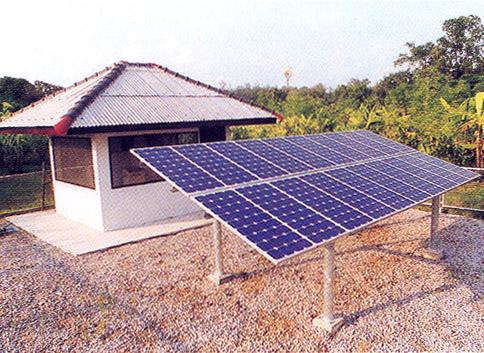
ระบบสูบน้ำด้วยกังหันลม โดยกรมพัฒนาและส่งเสริมพลังงาน (สนับสนุนโดยกองทุนเพื่อส่งเสริมการอนุรักษ์พลังงาน) และบริษัท อุสาพัฒนาเศรษฐกิจ จำกัด
จากข้อมูลลมบริเวณพื้นที่เขาหินซ้อน ความเร็วลมมีค่าเฉลี่ยประมาณ 7 กิโลกรัมต่อชั่วโมง วันละประมาณ 13 ชั่วโมง ดังนั้น โครงการฯ จึงนำกังหันลมสูบน้ำจำนวน 3 ระบบ มาติดตั้งใน 3 พื้นที่คือ พื้นที่แปลงเกษตรบริเวณอ่างเก็บนำห้วยเจ๊ก ศูนย์ส่งเสริมพืชสวนบริเวณห้วยน้ำโจน และโครงการพืชอายุสั้นบริเวณห้วยน้ำโจน
ระบบที่นำมาใช้งานแต่ละระบบประกอบด้วยกังหันลม ระบบส่งกำลังแบบเฟือง ขนาดความสูง 18 เมตร ความกว้างของใบพัด 14 ฟุต จำนวนใบพัด 30 ใบ เครื่องสูบน้ำแบบลูกสูบเส้นผ่าศูนย์กลาง 4.5 นิ้ว ระยะชัก 7 นิ้ว หอถังเหล็กสูง 12 เมตร ความจุ 12 ลูกบาศก์เมตร ท่อส่งนำเส้นผ่าศูนย์กลาง 1.5 นิ้ว และท่อดูดน้ำเส้นผ่าศูนย์กลาง 2 นิ้ว กังหันลมจะเริ่มทำงานที่ความเร็วลมประมาณ 4 กิโลเมตรต่อชั่งโมง จะสูบน้ำไปเก็บไว้ในหอถังสูงที่ระยะหัวยกน้ำประมาณ 18 เมตร โดยสูบน้ำได้วันละประมาณ 10-20 ลูกบาศก์เมตร ขึ้นอยู่กับความเร็วลม จากนั้นจึงปล่อยน้ำจากหอถังสูงผ่านระบบหัวฉีดย่อยหรือน้ำหยด ให้กับแปลงเกษตรกรรมต่อไป

ระบบผลิตไฟฟ้าด้วยเซลล์แสงอาทิตย์เชื่อมต่อสายส่งโดยการไฟฟ้าฝ่ายผลิตแห่งประเทศไทย (สนับสนุนโดยกองทุนเพื่อส่งเสริมการอนุรักษ์พลังงาน)
ระบบผลิตไฟฟ้าด้วยเซลล์แสงอาทิตย์เชื่อมต่อสายส่งนี้ติดตั้งที่อาคารศูนย์ประชาสัมพันธ์ประกอบด้วยเซลล์แสงอาทิตย์ขนาด 2,100 วัตต์ อุปกรณ์ควบคุม 1 ชุด เครื่องแปลงกระแสไฟฟ้า 1 ชุด และวัตต์มิเตอร์แสดงผลการผลิตไฟฟ้า 1 ชุด
ในเวลากลางวันที่มีแสงอาทิตย์ เซลล์แสงอาทิตย์จะทำหน้าที่เปลี่ยนพลังงานแสงเป็นพลังงานไฟฟ้ากระแสตรง จากการออกแบบระบบจะให้ไฟฟ้ากระแสตรงขนาดแรงดัน 220-240 โวลต์ และกระแสไฟฟ้า 6-8 แอมแปร์ ไฟฟ้ากระแสตรงที่ผลิตได้จะไหลผ่านเครื่องแปลงกระแสไฟฟ้าและถูกเปลี่ยนเป็นไฟฟ้ากระแสสลับที่มีแรงดัน 220 โวลต์ และมีคุณสมบัติเหมือนกับกระแสไฟฟ้าในระบบไฟฟ้าที่มีอยู่เดิม ดังนั้น กระแสไฟฟ้าที่ผลิตได้จากระบบนี้จึงสามารถใช้ได้กับเครื่องใช้ไฟฟ้าที่มีอยู่ทุกชนิด โดยในกรณีที่กระแสไฟฟ้า ที่ผลิตได้จากเซลล์แสงอาทิตย์มีมากกว่าความต้องการใช้ไฟฟ้าส่วนเกินจะถูกขายคืนเข้าในระบบสายส่งของการไฟฟ้าฯ ในทางกลับกันหากความต้องการใช้กระแสไฟฟ้าในขณะนั้นมีมากกว่ากระแสไฟฟ้าที่ผลิตได้ กระแสไฟฟ้าส่วนที่ขาดก็จะถูกซื้อเสริมเข้ามาจากระบบสายส่งของการไฟฟ้าฯ ตามปกติซึ่งการทำงานของระบบได้รับการออกแบบให้เป็นการทำงานแบบอัตโนมัติ ดังนั้นจึงไม่ต้องมีการปิด-เปิดระบบแต่อย่างใดในแต่ละวัน
ผลการติดตั้งระบบ ทำให้ปริมาณกระแสไฟฟ้าที่ซื้อจากระบบสายส่งของการไฟฟ้าฯ ลดลงเท่ากับปริมาณกระแสไฟฟ้าที่ผลิตได้จากระบบเซลล์แสงอาทิตย์ ซึ่งเท่ากับว่าจะสามารถช่วยลดการใช้เชื้อเพลิงบรรพชีวิน เช่น น้ำมัน ก๊าซธรรมชาติ หรือถ่านหิน ในการผลิตกระแสไฟฟ้าลง อันจะส่งผลให้มลพิษที่เกิดจากการเผาไหม้เชื้อเพลิงดังกล่าวลดลงได้อีกทางหนึ่ง
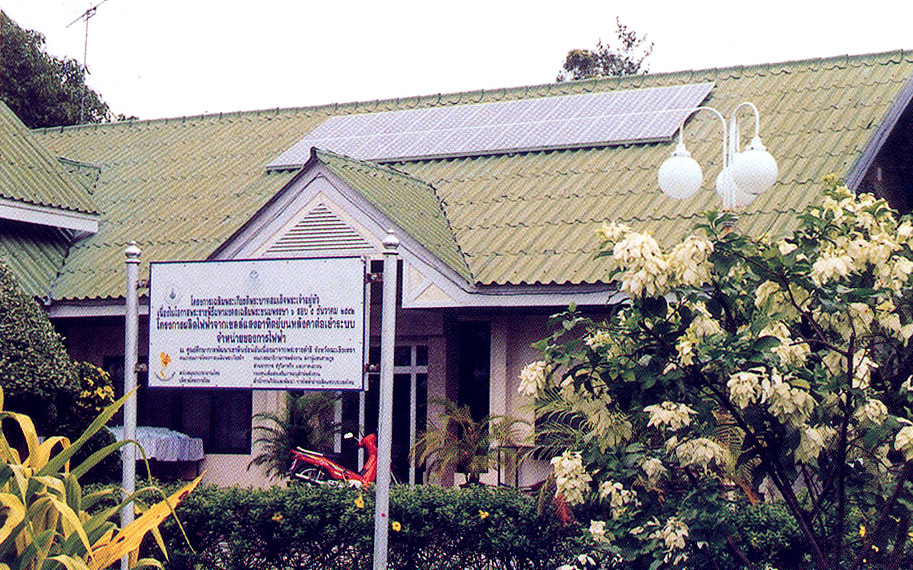
ย้ายและติดตั้งเพิ่มเติมระบบสูบน้ำด้วยไฟฟ้าจากเซลล์แสงอาทิตย์ โดยบริษัท บีพีไทยโซลาร์ จำกัด
เครื่องสูบน้ำเดิมที่บริษัท บีพีไทยโซลาร์ จำกัด ได้ถวายพระบาทสมเด็จพระเจ้าอยู่หัว เมื่อปี พ.ศ. 2533 ที่สระ 1 อ่างเก็บน้ำที่ 4 ได้เกิดการชำรุด เนื่องจากสูบน้ำที่เป็นกรดและน้ำที่แห้งขอด โครงการฯ จึงย้ายเครื่องสูบน้ำไปติดตั้งที่บริเวณอ่างเก็บน้ำลุ่มน้ำโจนแห่งที่ 10 ซึ่งมีน้ำที่เป็นกรดอ่อนกว่าและทางบริษัท บีพีไทยโซลาร์ จำกัด ได้ติดตั้งระบบสูบน้ำเพิ่มเติมด้วย
ระบบประกอบด้วยเซลล์แสงอาทิตย์ขนาด 58 วัตต์ จำนวน 28 แผง รวม 1,624 วัตต์ เครื่องสูบน้ำ 1 เครื่อง เครื่องแปลงกระแสไฟฟ้า 1 ชุด อุปกรณ์ควบคุม 1 ชุด ถังน้ำสูบ 1 ถัง และท่อโลหะส่งน้ำขนาดเส้นผ่าศูนย์กลาง 2.5 นิ้ว เป็นระยะทาง 300 เมตร โดยเครื่องสูบน้ำจะทำงานด้วยไฟฟ้าจากเซลล์แสงอาทิตย์ในเวลากลางวัน สูบน้ำไปเก็บในถังสูงได้วันละ 40-50 ลูกบาศก์เมตร ที่ระยะยกน้ำสูง 15 เมตร และใช้แรงโน้มถ่วงปล่อยน้ำสู่แปลงเกษตรทดลองผ่านหัวฉีดกระจายน้ำ
ระบบแสงไฟถนนด้วยเซลล์แสงอาทิตย์ 10 ชุด โดยบริษัท บีพีไทยโซลาร์ จำกัด
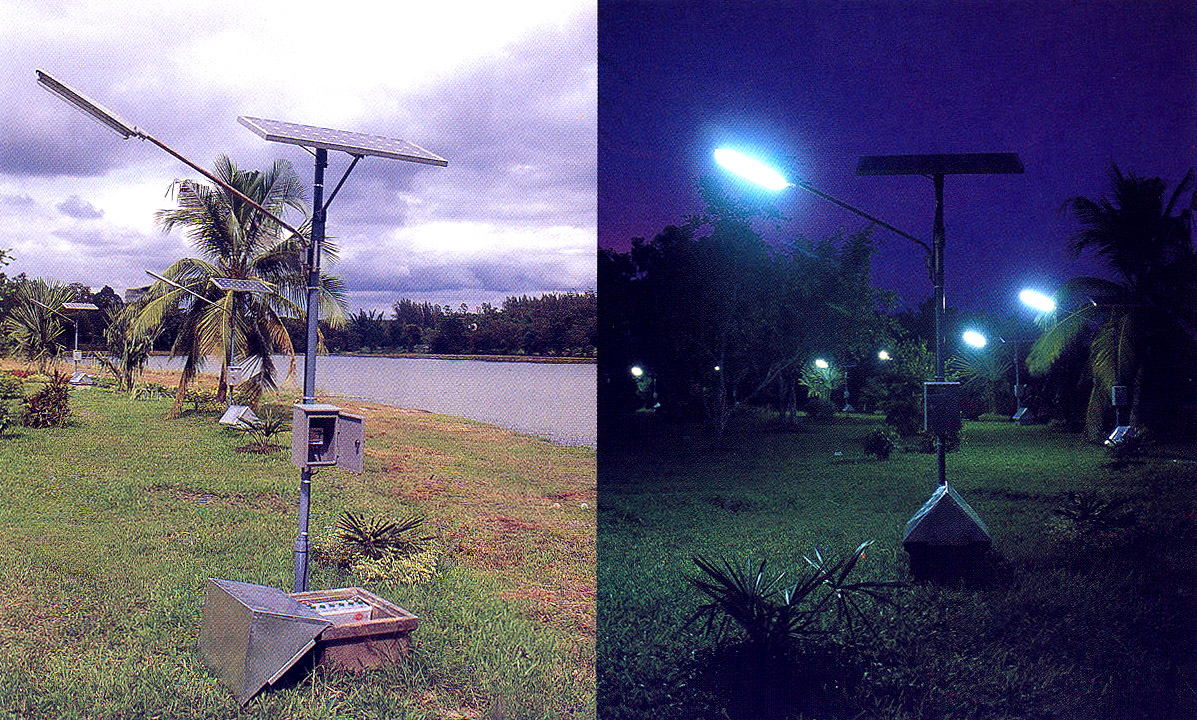
ภายในศูนย์ศึกษาการพัฒนาเขาหินซ้อนฯ มีการติดตั้งระบบแสงไฟถนนด้วยเซลล์แสงอาทิตย์จำนวน 10 ระบบ แต่ละระบบประกอบด้วย เซลล์แสงอาทิตย์ขนาด 75 วัตต์ อุปกรณ์ควบคุมแบตเตอรี่ หลอดไฟฟลูออเรสเซนต์ขนาด 18 วัตต์ และเสาไฟพร้อมโครงเหล็กยึดเซลล์แสงอาทิตย์
ลักษณะการทำงานของระบบ คือ เซลล์แสงอาทิตย์จะประจุกระแสไฟฟ้าลงในแบตเตอรี่ในเวลากลางวัน โดยผ่านอุปกรณ์ควบคุมที่ทำหน้าที่ประจุให้อยู่ในระดับที่พอเหมาะ ภายในเครื่องมีอุปกรณ์สั่งให้หลอดไฟสว่างเมื่อท้องฟ้าเริ่มมืด และสั่งให้หลอดไฟดับเมื่อท้องฟ้าเริ่มสว่างหรือเมื่อแบตเตอรี่มีไฟฟ้าไม่เพียงพอในช่วงที่มีแสงอาทิตย์น้อยเพื่อป้องกันไม่ให้แบตเตอรี่เสียหาย
ชุดแสงไฟล่อแมลงด้วยเซลล์แสงอาทิตย์ โดยบริษัท สยามโซลาร์ แอนด์ อีเลคทรอนิคส์ จำกัด
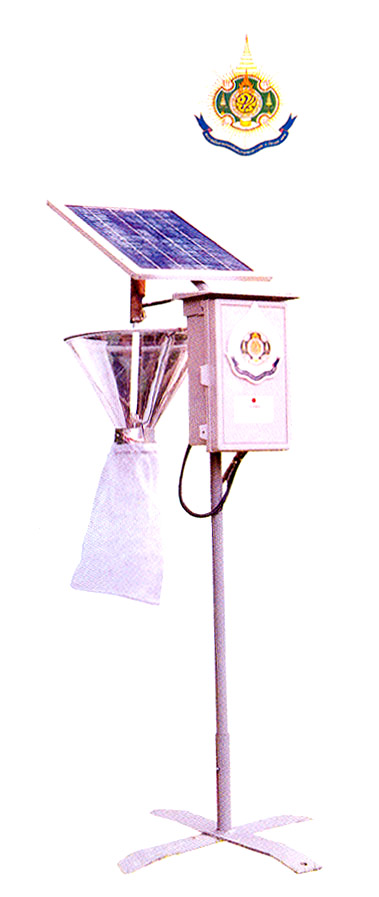
ที่ศูนย์ศึกษาการพัฒนาเขาหินซ้อนฯ แต่เดิมยังไม่มีเครื่องล่อแมลงที่จะใช้กำจัดแมลงบางชนิดที่เป็นศูนย์พืช จึงได้นำชุดแสงไฟล่อแมลงด้วยเซลล์แสงอาทิตย์มาติดตั้งภายในบริเวณศูนย์ฯ ซึ่งอุปกรณ์ชนิดนี้ออกแบบและผลิตโดยคนไทย เป็นอุปกรณ์ที่เคลื่อนย้ายง่าย ติดตั้งสะดวก และมีต้นทุนการผลิตต่ำ ประกอบด้วยเซลล์แสงอาทิตย์ขนาด 10 วัตต์ จำนวน 1 แผง หลอดไฟฟลูออเรสเซนต์ 6 วัตต์ จำนวน 1 ชุด แบตเตอรี่ขนาด 12 โวลต์ 4 แอมแปร์ชั่วโมง จำนวน 1 ลูก เซนเซอร์วัดความสว่าง 1 ชุด ชุดตั้งเวลาการทำงานของหลอดไฟกับพัดลม 1 ชุด พัดลมขนาด 2 นิ้ว 1 เครื่องชุดแสดงผลความจุแบตเตอรี่ 1 ชุด ถุงผ้าดักแมลง 1 ถุง และขาตั้งแบบเคลื่อนย้ายได้ 1 ชุด
การทำงานของระบบเป็นไปโดยเซลล์แสงอาทิตย์จะประจุกระแสไฟฟ้าลงในแบตเตอรี่ในเวลากลางวัน เมื่อดวงอาทิตย์ตกดิน เซนเซอร์วัดความสว่างจะสั่งให้หลอดไฟสว่างและพัดลมหมุนเป็นเวลา 2 ชั่วโมง เพราะโดยปกติแมลงจะออกมาเล่นไฟประมาณ 2 ชั่วโมง โดยในขณะที่หลอดไฟสว่างและพัดลมหมุนนั้น หากมีแมลงบินเข้าใกล้ก็จะถูกดูดให้ตกลงไปในถุง และแมลงที่ได้นี้สามารถนำไปใช้เลี้ยงปลาได้ นอกจากนี้ ชุดแสงไฟล่อแมลงยังสามารถติดตั้งไว้กลางบ่อเลี้ยงปลาเพื่อให้แมลงตกลงไปในบ่อปลาโดยตรงได้ด้วย
ชุดกรองน้ำดื่มระบบรีเวิร์สออสโมซิลทำงานด้วยไฟฟ้าจากเซลล์แสงอาทิตย์ โดยมหาวิทยาลัยเทคโนโลยีพระจอมเกล้าธนบุรี
ชุดกรองน้ำดื่มระบบรีเวิร์สออสโมซิสเป็นเครื่องฟอกน้ำจืด น้ำกร่อย หรือ น้ำทะเลให้เป็นน้ำจืดบริสุทธิ์ โดยมีหลักในการทำงาน คือ ใช้เยื่อเมมเบรน (membrane) ซึ่งเป็นเยื่อบางๆ คล้ายแผ่นกระดาษแต่มีเนื้อละเอียดถึง 0.0001 ไม่ครอน ทำให้โมเลกุลของสารละลายในน้ำไม่สามารถลอดผ่านไปได้ โดยเยื้อเมมเบรนจะทำงานควบคู่กับเครื่องสูบน้ำแรงดันสูงที่ทำหน้าที่ผลักดันน้ำดิบให้ผ่านเยื่อเมมเบรนเครื่องสูบน้ำดังกล่าวทำงานด้วยไฟฟ้าที่ผลิตจากเซลล์แสงอาทิตย์
ระบบที่นำมาติดตั้งนี้ประกอบด้วยแผงเซลล์แสงอาทิตย์ขนาด 60 วัตต์ แบตเตอรี่ขนาด 624 วัตต์ต่อชั่วโมง ชุดควบคุม และเครื่องสูบน้ำแรงดันสูง โดยการทำงานจะเริ่มจากการเปิดวาล์วให้น้ำดิบเข้าสู่ระบบไฟฟ้าจากเซลล์แสงอาทิตย์จะเดินเครื่องสูบน้ำให้ทำงานเพื่อเพิ่มความดันให้น้ำดิบ อัดน้ำผ่านส่วนไส้กรองคาร์บอนทั้งชนิดเม็ดและชนิดผง ส่วนเยื่อกรองเมมเบรน และส่วนไส้กรองคาร์บอนอันสุดท้านจนได้เป็นน้ำบริสุทธิ์
เครื่องสกัดสารกำจัดศัตรูพืชด้วยพลังงานแสงอาทิตย์ โดยบริษัท โซลาร์ตรอน จำกัด
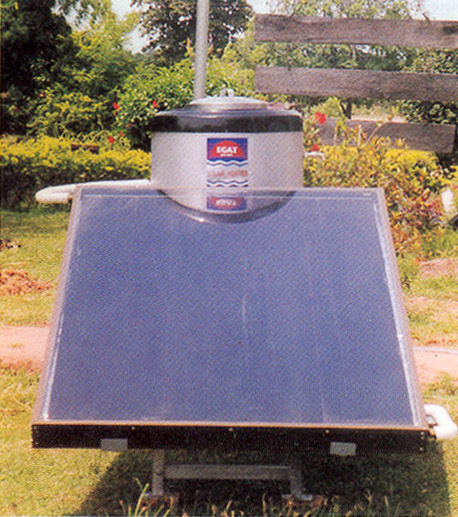
เครื่องสกัดสารกำจัดศัตรูพืชด้วยพลังงานแสงอาทิตย์ประกอบด้วยแผงรับพลังงานแสงอาทิตย์ 1 ชุด ถังสกัดสารไส้กรอง ท่อน้ำเข้าถังและท่อน้ำเข้าแผง วาล์วเช็คระดับน้ำขารับแผงและถัง เป็นอุปกรณ์ที่นำพลังงานความร้อนจากแสงอาทิตย์มาใช้ ประโยชน์ในการต้มสกัดสารชีวภาพ ซึ่งมีอยู่ในสมุนไพรบางชนิด เช่น ตะไคร้ หอม สะเดา ข่า และอื่นๆ โดยการทำงานจะเริ่มต้นขึ้นเมื่อแสงอาทิตย์ตกกระทบแผงรับแสงอาทิตย์ พลังงานความร้อนจะถูกดูดซับและส่งถ่ายความร้อนให้กับน้ำที่อยู่ในระบบ ทำให้น้ำร้อนและลอยตัวขึ้นที่สูงแล้วไหลไปตามท่อหุ้มฉนวนเข้าสู่ถังสกัดสารกำจัดศัตรูพืชหรือหม้อต้มซึ่งใส่สมุนไพรไว้ ขณะเดียวกันน้ำส่วนล่างของหม้อต้มก็จะไหลไปตามท่อหุ้มฉนวนด้านตรงข้ามเข้าสู่แผงรับแสงอาทิตย์เพื่อรับพลังงานความร้อนจากแผงเป็นวัฏจักรเรียกว่า ระบบไหลเวียนตามธรรมชาติ น้ำในหม้อต้มจะมีอุณหภูมิสูงขึ้นเรื่อยๆ จนถึงประมาณ 90 องศาเซลเซียส โดยใช้เวลาวันละ 6-8 ชั่วโมง ก็จะได้น้ำสารสกัดจากพืชสมุนไพร 75-100 ลิตรต่อวัน เมื่อปล่อยให้เย็นก็สามารถนำน้ำสารสกัดไปฉีดพ่นพืชผักผลไม้ได้ทันที เพื่อป้องกันศัตรูพืชที่จะมาทำลาย
ระบบเครื่องขยายเสียงพลังงานแสงอาทิตย์ โดยบริษัท โซลาร์ตรอน จำกัด
เครื่องขยายเสียงพลังงานแสงอาทิตย์ ประกอบด้วยแผงเซลล์แสงอาทิตย์ขนาด 6 วัตต์ 12 โวลต์ 0.3 แอมแปร์ จำนวน 1 แผง แบตเตอรี่แบบ sealed lead acid ขนาด 12 โวลต์ 0.7 แอมแปร์ จำนวน 1 ลูก และเครื่องขยายเสียง พร้อมไมโครโฟนแบบมีสายและแบบไร้สาย จำนวน 1 ชุด ชุดเครื่องขยายเสียงถูกดัดแปลงให้สามารถใช้ได้ทั้งไฟฟ้ากระแสตรงและไฟฟ้ากระแสสลับ มีขนาดกำลังขยาย 50 วัตต์ โดยสามารถใช้งานได้ทั้งไมโครโฟนแบบมีสายและแบบไร้สายซึ่งใช้กระแสไฟฟ้าขนาด 0.5 แอมแปร์ และสามารถใช้งานในภาคสนามและเลือกใช้ตามความเหมาะสมได้อีกด้วย
เครื่องวัดพลังงานแสงอาทิตย์ โดยมหาวิทยาลัยเทคโนโลยีพระจอมเกล้าธนบุรี
เครื่องวัดพลังงานแสงอาทิตย์ ประกอบด้วย 2 ส่วน ได้แก่
1. ส่วนเซนเซอร์หรือไพรานอมิเตอร์ ประกอบด้วยเซลล์แสงอาทิตย์ชนิดผลึกซิลิคคอนขนาด 1 ตารางเซนติเมตร และขั้วของเซลล์และอาทิตย์
2. ส่วนอินติเกรตสัญญาณ ทำหน้าที่แสดงผลและอินติเกรตค่าความเข้มรังสีดวงอาทิตย์เป็นพลังงาน
ประโยชน์ของเครื่องวัดพลังงานแสงอาทิตย์ คือสามารถวัดค่าพลังงานแสงอาทิตย์ในช่วงเวลาต่างๆ ซึ่งทำให้ทราบประสิทธิภาพการทำงานของระบบพลังงานทดแทนที่ใช้พลังงานแสงอาทิตย์ อันเป็นประโยชน์ต่อการพัฒนาระบบและอุปกรณ์ต่างๆ ในอนาคตได้
มุ้งแอร์สุขภาพรุ่นประหยัดพลังงาน โดยนายศฤงคาร รัตนางศุ (สมาคมการประดิษฐ์ไทย)

มุ้งติดแอร์ ประกอบด้วยโครงเหล็กขนาดเล็กแบบถอดประกอยได้ มีหลังคาทรงโค้งคล้ายทรงโดมและมีทางเข้าออก โดยตัวมุ้งผลิตจากผ้าชนิดพิเศษและมีน้ำหนักเบาเป็นลักษณะ 2 ชั้น ชั้นนอกโปร่งและชั้นในทึบเพื่อเป็นฉนวนความร้อน โดยมีช่องแอร์สำหรับต่อเข้ากับเครื่องปรับอากาศเคลื่อนที่ขนาดเล็กที่มีระบบฟอกอากาศ ด้านหน้าพ่นลมเย็น ด้านหลังพ่นลมร้อนซึ่งสามารถใช้เป็นเครื่องทำความอุ่นให้กับมุ้งติดแอร์ได้ เครื่องปรับอากาศเคลื่อนที่ขนาดเล็กนี้สามารถนำมาใช้ทดแทนพัดลมซึ่งให้ลมเย็นกว่าพัดลมไอน้ำ และเนื่องจากเป็นเครื่องปรับอากาศเล็กจึงสิ้นเปลืองพลังงานไฟฟ้าน้อยมาก
ภายหลังจากที่โครงการฯ นำระบบพลังงานทดแทนติดตั้งที่ศูนย์ศึกษาการพัฒนาเขาหินซ้อนฯ เป็นระยะเวลาหนึ่งแล้ว คุณเกรียงศักดิ์ หงษ์โต ผู้อำนวยการศูนย์ศึกษาการพัฒนาเขาหินซ้อนฯ ได้แสดงความคิดเห็นเกี่ยวกับพลังงานทดแทน ดังนี้
ความคิดเห็นเกี่ยวกับการจัดการด้านพลังงานของประเทศไทย
คุณเกรียงศักดิ์ : "การจัดการด้านพลังงานที่ดีนั้น เราต้องย้อนไปมองถึงเรื่องทรัพยากรธรรมชาติที่เรามีอยู่เสียก่อน เพราะว่าแหล่งของพลังงานธรรมชาติก็คือทรัพยากร อย่างเช่น ถ้าเรามีป่าสมบูรณ์เราก็ไม่ต้องมีปัญหาเรื่องน้ำ ไม่ต้องมีปัญหาเรื่องการปรับปรุงดิน ตรงจุดนี้เองที่ทำให้ผมมองเห็นว่า เรายังขาดการจัดการทรัพยากรที่ดีและสอดคล้องกับภูมิศาสตร์บ้านเรา อย่างบ้านเรามีพลังงานธรรมชาติอยู่มากมายขึ้นอยู่กับว่าเราจะนำมาใช้ให้เกิดประโยชน์อย่างต่อเนื่องได้อย่างไร"
การแก้ปัญหาด้านพลังงานของประเทศไทยควรจะเป็นไปในแนวทางใด
คุณเกรียงศักดิ์ : "การแก้ปัญหาด้านพลังงานนั้นจะต้องแก้ตั้งแต่รากของปัญหา นั้นก็คือสำนึกในการจัดการทรัพยากรธรรมชาติ เพราะการจะเปลี่ยนทัศนคติของคนไทยที่แต่เดิมเขาก็มีพลังงานใช้ มีไฟฟ้าใช้อย่างสะดวกสบายอยู่แล้วไม่ใช่เรื่องง่าย การแก้ปัญหาจึงต้องมองภาพรวมทั้งหมด ต้องมองทั้งกระบวนการจัดการ ผมเชื่อว่าทุกคนก็รับรู้อยู่แล้วว่า พลังงานแสงอาทิตย์ พลังงานลมนั้นมีมากมาย แล้วก็ดีแน่ๆ แต่การลงทุนในเบื้องต้นที่จะนำมาใช้นั้นสูงแค่ไหน การดูแลรักษาในเรื่องเทคโนโลยีจะเป็นอย่างไร ซึ่งตรงนี้เรายังมีความรู้ความเข้าใจกันอยู่น้อยมาก จุดนี้เองที่เราจะต้องมีการพัฒนาต่อไป"
ความคาดหมายที่จะได้รับจากโครงการนำพลังงานทดแทนมาใช้งานที่ศูนย์ศึกษาการพัฒนาเขาหินซ้อนฯ
คุณเกรียงศักดิ์ : "วัตถุประสงค์ของโครงการนี้ก็เพื่อลดการใช้พลังงานเชื้อเพลิงที่เป็นพลังงานนำเข้าแต่การนำพลังงานธรรมชาติมาใช้ในประเทศของเรานั้นยังต้องมีการพัฒนาอีก เพื่อให้ในวันหนึ่งข้างหน้าการลงทุนติดตั้งจะได้มีราคาถูกลง และชาวบ้านที่มีรายได้ไม่มากนักสามารถนำไปใช้ได้มากขึ้น อย่างไรก็ตาม ตอนนี้เราก็สามารถนำมาใช้ในบางส่วนซึ่งก็ช่วยประหยัดไปได้มากเหมือนกัน แล้วลองคิดดูว่าถ้าคนจำนวน 60 ล้านคน ทั้งประเทศช่วยกัน เราจะสามารถประหยัดพลังงานที่ต้องนำเข้า ประหยัดรายจ่ายของประเทศไปได้มากแค่ไหน
"ส่วนตัวผมเองเห็นด้วยที่หน่วยงานต่างๆ ได้เข้ามาร่วมกันทำตรงจุดนี้ เพื่อเทิดพระเกียรติในวโรกาสเฉลิมพระชนมพรรษาครบ 72 พรรษาของพระองค์ท่าน เพราะว่าจากตรงนี้เราจะได้เก็บตัวเลขข้อมูลที่ได้จากการใช้งาน เพื่อเผยแพร่ให้ผู้ที่เข้ามาเยี่ยมชมหรือมาดูงานภายในศูนย์ ได้เรียนรู้ว่า ระบบพลังงานทดแทนเป็นอย่างไร ใช้ได้ผลแค่ไหน มีระบบการทำงานเป็นอย่างไร มีปัญหาอย่างไร มีข้อดีข้อเสียตรงไหน เพื่อจะเป็นทางเลือกให้กับเขาได้นำไปใช้หรือพัฒนาต่อไปได้"
ที่มา : พระบิดาแห่งการพัฒนาพลังงานไทย
โครงการผลิตพลังงานทดแทนของโครงการส่วนพระองค์ สวนจิตรลดา
โครงการผลิตพลังงานทดแทนของโครงการส่วนพระองค์ สวนจิตรลดา
ความเป็นมาของโครงการส่วนพระองค์ สวนจิตรลดา
ตลอดระยะเวลากว่าห้าสิบสามปีนับตั้งแต่เถลิงถวัลยสิริราชสมบัติเมื่อวันที่ 9 มิถุนายน พ.ศ. 2489 นั้น พระอัจฉริยภาพของพระบาทสมเด็จพระเจ้าอยู่หัวในด้านต่างๆ ได้เป็นที่ประจักษ์แกพสกนิกรชาวไทยมาตลอด โดยเฉพาะพระปรีชาสามารถทางด้านวิทยาศาสตร์และเทคโนโลยีที่พระองค์ได้ทรงศึกษาค้นคว้าความรู้อย่างต่อเนื่อง เพื่อนำมาใช้เป็นแนวทางอำนวยประโยชน์ให้ประชาราษฎร์ได้อยู่ดีกินดีในโครงการพัฒนาอันเนื่องมาจากพระราชดำริโครงการต่างๆ โดยโครงการส่วนพระองค์ สวนจิตรลดา ก็เป็นหนึ่งใน 3,000 กว่าโครงการที่ได้ริเริ่มขึ้นจนถึงปัจจุบัน
โครงการส่วนพระองค์ สวนจิตรลดา มีวัตถุประสงค์ 3 ประการ คือ
1. เป็นโครงการทดลอง โดยเก็บข้อมูลไว้เพื่อศึกษาและเพื่อผู้ที่สนใจขอข้อมูลมาเพื่อศึกษา ถ้าต้องการจะทำตามหรือคิดว่าโครงการนี้ดีเป็นตัวอย่าง ก็ขอข้อมูลไปเพื่อพิจารณา และเริ่มกิจกรรมของหน่วยงานนั้น
2. เป็นโครงการตัวอย่าง
3. เป็นโครงการที่ไม่หวังผลกำไร หมายถึง โครงการใดก็ตามที่จัดทำขึ้นนั้น ถ้าหากว่าขาดทุนก็ยังทำต่อไป แต่จะพิจารณาหาโครงการอื่นซึ่งสามารถที่จะทำกำไร นำมาสนับสนุนโครงการที่ขาดทุน เพราะฉะนั้นต้องไม่ท้อถอยต่อการที่จะทำแล้วขาดทุนต่อไป
โครงการส่วนพระองค์ฯ แบ่งออกเป็น 2 รูปแบบ คือ
1. แบบไม่ใช่ธุรกิจ โครงการแบบไม่ใช่ธุรกิจ หมายถึง โครงการที่ได้รับการสนับสนุนจากราชการหลายๆ หน่วยงาน เพราะฉะนั้นจึงไม่มีรายรับและรายจ่ายประจำ เช่น การเลี้ยงและขยายพันธุ์ปลาหมอเทศ ทำป่าไม้สาธิต หาข้าวทดลอง เลี้ยงโคนม การเลี้ยงขยายพันธุ์ปลานิล ปลูกข้าวไร่ จัดทำก๊าซชีวภาพ เพาะเลี้ยงเนื้อเยื่อพืชสวนพืชสมุนไพร อาคารวิจัยและพัฒนา
2. แบบกึ่งธุรกิจ ไม่ใช่ธุรกิจเต็มตัว เป็นโครงการที่มีรายรับและรายจ่าย ที่เรียกว่ากึ่งธุรกิจก็เพราะว่าไม่มีการแจกผลกำไร ไม่แบ่ง เพราะนำผลกำไรมาขยายงาน โครงการแบบกึ่งธุรกิจ ได้แก่ โรงโคนม ศูนย์รวมนม โรงสีข้าวทดลอง โรงบดและอัดแกลบ ห้องปฎิบัติการทดลองเพื่อตรวจสอบคุณภาพของผลผลิต โรงผลิตน้ำผลไม้ โรงนมผงสวนดุสิต โรงนมเม็ด โรงเนยแข็ง โรงอบผลไม้ โรงบดและอัดแกลบ โรงกลั่นแอลกฮอล์เพื่อการค้นคว้าน้ำมันเชื้อเพลิง เช่น นำแอลกอฮอล์มาผสมกับน้ำมันเบนซินเป็นแก๊สโซฮอล์ โรงหล่อเทียนหลวง โรงผลิตกระดาษสา โรงเห็ดและโรงอาหารปลา เป็นต้น และมีโครงการวิจัยและพัฒนาปรับปรุงคุณภาพของผลผลิต ค้นคว้าเกี่ยวกับผลิตภัณฑ์ใหม่ของโครงการฯ ตลอดจนส่งเสริมเพิ่มความรู้ความสามารถให้กับเจ้าหน้าที่เป็นขวัญและกำลังใจเพื่อการวิจัยและพัฒนาของโครงการฯ
โครงการผลิตพลังงานทดแทนของโครงการส่วนพระองค์ สวนจิตรลดา
โครงการผลิตพลังงานทดแทนซึ่งดำเนินการโดยโครงการส่วนพระองค์ สวนจิตรลดา ได้แก่ โครงการผลิตเชื้อเพลิงอัดแท่ง (แกลบอัดแท่ง) โครงการผลิตแก๊สโซฮอล์ และโครงการบ้านพลังงานแสงอาทิตย์ เป็นโครงการที่พระบาทสำเด็จพระเจ้าอยู่หัวได้ทรงมีพระราชดำริให้ริเริ่มขึ้นเพื่อการค้นคว้าพลังงานทดแทนอื่น แทนพลังงานจากน้ำมันและเชื้อเพลิงอื่น และใช่ประโยชน์จากวัสดุเหลือใช้ให้ได้ผลคุ้มค่ามากที่สุด
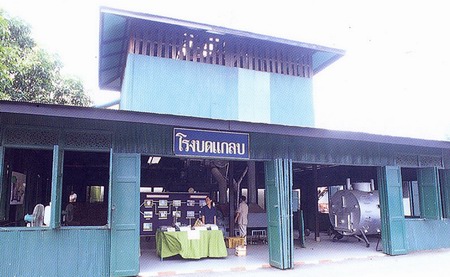
โครงการผลิตเชื้อเพลิงอัดแท่ง (แกลบอัดแท่ง)
ปกติหลังการสีข้าว จะได้แกลบซึ่งอาจนำไปใช้เป็นอาหารสัตว์ ทำเป็นปุ๋ย และเชื้อเพลิงได้ตามความต้องการ โดยเฉพาะการใช้งานแกลบเป็นเชื้อเพลิงได้อย่างมีประสิทธิภาพสูงขึ้นและสะดวกต่อการใช้งานนั้น พระบาทสมเด็จพระเจ้าอยู่หัวทรงมีพระราชดำริตั้งแต่ พ.ศ. 2518 ว่า ควรมีการนำแกลบมาใช้งานให้เป็นประโยชน์ทั้งทางด้านการทำเป็นปุ๋ยสำหรับปรับปรุงสภาพดินและทำเป็นเชื้อเพลิง ซึ่งจะช่วยอนุรักษ์ป่าไม้ได้อีกทางหนึ่งด้วย
ต่อมาในปี พ.ศ. 2523 จึงได้มีการทดลองนำแกลบมาอัดให้เป็นแท่งและแปรสภาพให้เป็นเชื้อเพลิงแท่ง เริ่มจากการนำแกลบที่ได้จากโรงสีข้าวตัวอย่างในสวนจิตรดามาทดลองใช้งาน โดยได้รับความร่วมมือในการวิจัยและค้นคว้าจากสถาบันวิจัยวิทยาศาสตร์และเทคโนโลยีแห่งประเทศไทย
แกลบที่ได้จากโรงสีข้าวตัวอย่างในสวนจิตรลดาจะถูกเลือกใช้เฉพาะส่วนที่มีความชื้นไม่เกินร้อยละ 10 ขั้นตอนการผลิตเริ่มจากการขับแกลบให้ไหลผ่านสกรู แล้วจะมีเครื่องทำหน้าที่บดแกลบให้ละเอียดและทำให้แน่นผ่านกระบอก โดยกระบอกจะถูกเผาด้วยเศษแกลบอัดแท่งซึ่งมีความร้อนประมาณ 250-270 องศาเซลเซียสและเนื่องจากวัสดุแกลบประกอบด้วยสารเซลลูโลส ลิกนิน และคาร์โบไฮเดรต ดังนั้นเมื่อสารเซลลูโลสถูกความร้อนจากกระบอก สารเซลลูโลสจะหลอมละลายและเคลือบด้านนอกของแท่งแกลบให้แข็ง ทำให้แกลบเกาะกันเป็นแท่ง
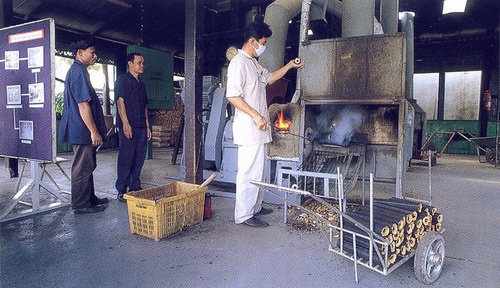
ระหว่างการทำวิจัยและทดลองในเบื้องต้นพบว่ามีปัญหาต่างๆ เกิดขึ้น เช่น สกรูด้านหน้าของ เครื่องอัดแท่งสึกหรอเร็ว สารที่ทำให้สกรูสึกหรอเร็ว ได้แก่ สารซิลิกา เมื่อเดินเครื่องได้ประมาณ 21 ชั่วโมงจะต้องทำการถอดสกรูมาเชื่อมและพอกใหม่ ในปัจจุบันกำลังมีการศึกษาและวิจัยหาวิธีการที่จะทำให้สกรูใช้งานได้นานกว่าที่ใช้อยู่เดิม ขณะเดียวกันแกลบอัดแท่ง เมื่อนำมาทำให้เป็นเชื้อเพลิงจะมีควันมาก จึงต้องกำจัดควันโดยการนำแกลบอัดแท่งเข้าเตาเผาให้เป็นถ่าน แกลบอัดแท่งจะอยู่ในเตาเผาประมาณ 4 วันเมื่อได้ถ่านแล้วจึงนำถ่านออกจากเตา
เมื่อต้องการนำถ่านแกลบไปใช้งาน จะต้องนำถ่านแกลบมาสับเป็นชิ้นเล็กๆ เพื่อสะดวกในการบรรจุใส่ถุงเพื่อจำหน่าย ถ่านแกลบ 1 ถุง มีน้ำหนัก 2 กิโลกรัม จำหน่ายกิโลกรัมละ 5 บาท หรือ 1 ถุง ราคา 10 บาท โดยความร้อนที่ได้จากการใช้ถ่านแกลบมีดังนี้
แกลบอัดแท่ง ให้ความร้อนประมาณ 3,886 กิโลแคลอรี่ ต่อ 1 กิโลกรัม
ถ่านแกลบ ให้ความร้อนประมาณ 4,730 กิโลแคลอรี่ ต่อ 1 กิโลกรัม
ถ่านไม้โดยทั่วไป ให้ความร้อนประมาณ 7,450 กิโลแคลอรี่ ต่อ 1 กิโลกรัม
ประโยชน์ที่ได้จากการนำแกลบมาแปรสภาพเป็นถ่านแกลบจึงมีอยู่หลายด้าน ทั้งในแง่ของการ นำแกลบซึ่งเป็นวัสดุเหลือใช้มาผลิตเป็นเชื้อเพลิงแท่งใช้แทนถ่านไม้ได้คุ้มค่า ช่วยอนุรักษ์ป่าไม้ และไม่ทำลายสภาพสิ่งแวดล้อม
โครงการทดลองผลิตแก๊สโซฮอล์
งานทดลองผลิตภัณฑ์เชื้อเพลิงเริ่มขึ้นเมื่อ พ.ศ. 2528 ครั้งนั้นพระบาทสมเด็จพระเจ้าอยู่หัวได้เสด็จพระราชดำเนินตรวจเยี่ยมโครงการส่วนพระองค์ สวนจิตรลดา และมีพระราชกระแสรับสั่งให้ศึกษาต้นทุนการผลิตแอลกอฮอล์จากอ้อย เพราะในอนาคตอาจเกินเหตุการณ์น้ำมันขาดแคลนหรืออ้อยราคาต่ำ การนำอ้อยมาแปรรูปเป็นแอลกอฮอล์เพื่อใช้เป็นพลังงานทดแทน จึงเป็นแนวทางหนึ่งที่จะแก้ไขปัญหานี้ได้ พระบาทสมเด็จพระเจ้าอยู่หัวได้พระราชทานเงินทุนวิจัยในการดำเนินงาน 925,500 บาท เพื่อใช้ในการจัดสร้างอาคาร และอุปกรณ์ต่างๆ ในการทดลองนี้
วันที่ 9 พฤษภาคม พ.ศ. 2529 พระบาทสมเด็จพระเจ้าอยู่หัว พร้อมด้วยสมเด็จพระเทพรัตนราชสุดาฯ สยามบรมราชกุมารี เสด็จพระราชดำเนินทรงเปิดอาคารโครงการค้นคว้าน้ำมันเชื้อเพลิงและเริ่มผลิตแอลกอฮอล์จากอ้อย โดยสามารถผลิตเอทิลแอลกอฮอล์ความบริสุทธิ์ 91% ได้ในอัตรา 2.8 ลิตรต่อชั่วโมง ต้นทุนการผลิต 56.2 บาทต่อลิตร ขณะที่เอทิลแอลกอฮอล์ความบริสุทธิ์ 95% ซึ่งผลิตจากกากน้ำตาลของกรมสรรพสามิตจำหน่ายในราคาประมาณ 24 บาทต่อลิตร
ต่อมาในปี พ.ศ. 2533 ฝ่ายเทคนิคบริษัทสุราทิพย์ได้ช่วยปรับปรุงหอกลั่นแอลกอฮอล์ ให้สามารถกลั่นได้ความบริสุทธิ์ 95% ในอัตรา 5 ลิตรต่อชั่วโมง ใช้กากน้ำตาลเป็นวัตถุดิบในการหมัก ซึ่งบริษัทสุราทิพย์น้อมเกล้าฯ ถวายเพื่อใช้ในการนี้เดือนละประมาณ 2 ตัน มีต้นทุนในการผลิตเอทิลแอลกอฮอล์ความบริสุทธิ์ 94% จากกากน้ำตาลประมาณ 35 บาทต่อลิตร
เดือนตุลาคม พ.ศ. 2537 โครงการส่วนพระองค์ สวนจิตรลดา ร่วมกับบริษัทสุราทิพย์ขยายกำลังการผลิตแอลกอฮอล์เพื่อให้มีพอใช้ผสมกับเบนซินธรรมดาในอัตรา 1 : 4 เป็นแก๊สโซฮอล์ สำหรับรถยนต์ทุกคันของโครงการฯ ที่ใช้เบนซิน โครงการทดลองนี้จัดเป็นโครงการหนึ่งในหกโครงการเฉลิมพระเกียรติเนื่องในมหามงคลวโรกาสเสด็จเถลิงถวัลยราชสมบัติ 50 ปี ของสำนักพระราชวัง
ในเดือนพฤษภาคม พ.ศ. 2538 สมเด็จพระเทพรัตนราชสุดาฯ สยามบรมราชกุมารีเสด็จพระราชดำเนินทรงเปิดโรงงานผลิตแอลกอฮอล์เป็นเชื้อเพลิงที่บริษัทสุราทิพย์น้อมเกล้าฯ ถวายและดำเนินการ กลั่นตลอดมาจนถึงปัจจุบัน กำลังการผลิตหอกลั่นขนาด 25 ลิตรต่อชั่วโมง คิดเป็นต้นทุนการผลิตแบบธุรกิจทั่วไป 32 บาทต่อลิตร ถ้าคิดต้นทุนการผลิตแบบยกเว้นต้นทุนคงที่ราคา 12 บาทต่อลิตร (ทำการผลิต 4 ครั้งต่อเดือน) ได้แอลกอฮอล์ประมาณ 900 ลิตรต่อการกลั่น 1 ครั้ง ใช้กากน้ำตาลความหวาน 49% (โดยน้ำหนัก) ครั้งละ 3,6400 กิโลกรัม น้ำกากส่า (น้ำเสียจากหอกลั่น) จะใช้รดกองปุ๋ยหมักที่โรงงานผลิตปุ๋ยอินทรีย์

ในเดือนพฤษภาคม พ.ศ. 2539 การปิโตรเลียมแห่งประเทศไทยและสถาบันวิจัยวิทยาศาสตร์และเทคโนโลยีแห่งประเทศไทย ร่วมกับโครงการส่วนพระองค์ฯ ได้ดำเนินการปรับปรุงคุณภาพของแอลกอฮอล์ที่ใช้เติมรถยนต์ โดยให้โครงการฯ ส่งแอลกอฮอล์ 95% ไปกลั่นซ้ำเป็นแอลกอฮอล์ 99% ที่ สถาบันวิจัยฯ แล้วนำกลับมาผสมกับเบนซินธรรมดาเป็นแก๊สโซฮอล์เติมให้กับรถยนต์ของโครงการฯ ที่ใช้เบนซินเป็นเชื้อเพลิง โดยสามารถเติมแก๊สโซฮอล์ได้จากสถานีบริการของการปิโตรเลียมแห่งประเทศไทยซึ่งตั้งอยู่ในบริเวณโครงการส่วนพระองค์ สวนจิตรลดา
ปัจจุบันโครงการแก๊สโซฮอล์ใช้แอลกอฮอล์ 99% ผสมกับเบนซินธรรมดาในอัตราส่วน 1 : 9 และเติม corrosion inhibitor (เป็นสารเคมีประเภทอะมีนและกรดอินทรีย์) 15 มิลลิกรัม ต่อแก๊สโซฮอล์ 1 ลิตร
ส่วนโครงการดีโซฮอล์ได้เริ่มขึ้นในปี พ.ศ. 2541 โดยการปิโตรเลียมแห่งประเทศไทย ร่วมกับโครงการส่วนพระองค์ ทดลองผสมแอลกอฮอล์ 95% กับน้ำมันดีเซลและสารอีมัลซิไฟเออล์ (สารอิมัลซิไฟเออร์ประกอบด้วย PEOPS และ SB 407) ในอัตราส่วน 13 : 86 : 1 ซึ่งจะนำไปใช้กับรถเครื่องยนต์ดีเซล เช่น รถปิคอัพ รถแทรกเตอร์ ของโครงการฯ จากผลการทดลองพบว่าสามารถใช้เป็นเชื้อเพลิงได้ดีพอสมควรและสามารถลดควันดำได้ประมาณ 50%
โครงการเครื่องอบแห้งพลังงานแสงอาทิตย์
เมื่อปี พ.ศ. 2538 ภาควิชาฟิสิกส์ คณะวิทยาศาสตร์ มหาวิทยาลัยศิลปากร ร่วมกับสถาบันวิศวกรรมเกษตรสำหรับเมืองร้อนและกึ่งร้อน มหาวิทยาลัยโฮเฮนไฮม์ ภาคเอกชนสถาบันไอเซลเลนและบริษัทเกวุสมิลเลอร์ ประเทศเยอรมันนี ได้น้อมเกล้าน้อมกระหม่อมถวายเครื่องอบแห้งพลังงานแสงอาทิตย์แบบอุโมงค์ลมร้อน (tunnel solar dryer) โดยมีแผงรับความร้อนจากแสงอาทิตย์และมีพัดลมเป็นตัวเป่าลมร้อนที่เกิดขึ้นสามารถนำไปใช้อบผลิตผลทางการเกษตรต่างๆ เช่น เมล็ดธัญพืช เมล็ดถั่ว ผัก ผลไม้ พืชสมุนไพร ตลอดจนผลิตภัณฑ์เนื้อและผลิตภัณฑ์ประมง เพื่อเป็นการประหยัดพลังงานไฟฟ้าในการอบแห้งผลิตภัณฑ์อบแห้งของโครงการส่วนพระองค์ฯ ได้แก่ การทำกล้วยตาก และผลไม้อบแห้งอื่นๆ

ในโครงการส่วนพระองค์ สวนจิตรลดา มีกังหันลมสูบน้ำจำนวน 2 เครื่อง ติดตั้งที่บริเวณด้านหน้าโครงการส่วนพระองค์ฯ และบริเวณโรงเพาะเห็ด ขนาดความสูง 18 เมตร ขนาดความกว้างของใบพัด 20 ฟุต จำนวนใบพัด 45 ใบ ปริมาณน้ำที่สูบได้ 2,000-24,000 ลิตรต่อชั่วโมง (ที่ความเร็วลม 4-30 กิโลเมตรต่อชั่วโมง) ท่อดูดและส่งน้ำมีขนาดเส้นผ่านศูนย์กลาง 8 นิ้ว ปัจจุบันกังหันลมทั้ง 2 เครื่องใช้สูบน้ำจากคลองรอบพระตำหนักเข้ามาที่บ่อเลี้ยงปลานิลที่ด้านหน้าโครงการฯ และนำน้ำจากคลองมาใช้ในการอุปโภคที่บริเวณโรงเพาะเห็ด
กังหันลมสูบน้ำในโครงการส่วนพระองค์ สวนจิตรลดา
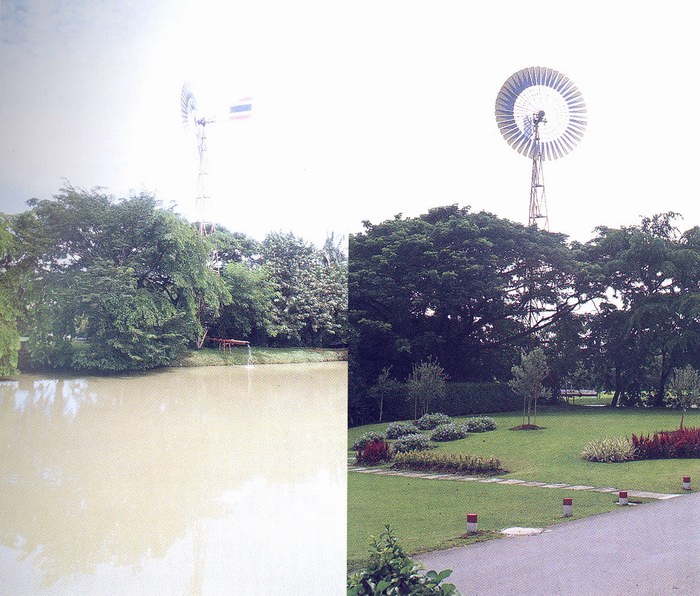
โครงการบ้านพลังงานแสงอาทิตย์
โครงการบ้านพลังงานแสงอาทิตย์เป็นโครงการที่กระทรวงกลาโหม กรมการพลังงานทหาร ศูนย์การอุตสาหกรรมป้องกันประเทศและพัฒนาพลังงานทหารได้จัดทำขึ้น เพื่อน้อมเกล้าน้อมกระหม่อมถวายแด่พระบาทสมเด็จพระเจ้าอยู่หัว ณ พระราชวังสวนจิตรลดา เนื่องในวโรกาสที่พระบาทสมเด็จพระเจ้าอยู่หัวทรงครองราชย์เป็นปีที่ 50 โดยใช้ชื่อโครงการว่า "โครงการพัฒนาระบบผลิตพลังงานไฟฟ้าจากเซลล์แสงอาทิตย์เฉลิมพระเกียรติ" สมเด็จพระเทพรัตนราชสุดาฯ สยามบรมราชกุมารี เสด็จแทนพระองค์เป็นประธานในพิธีเปิดการใช้งานบ้านพลังงานแสงอาทิตย์เมื่อวันที่ 16 พฤษภาคม พ.ศ. 2539
วัตถุประสงค์ของโครงการบ้านพลังงานแสงอาทิตย์ คือ
1. เพื่อปูพื้นฐานการอนุรักษ์พลังงานและใช้พลังงานทดแทน โดยการใช้พลังงานแสงอาทิตย์ซึ่งมีอยู่ทั่วไปในประเทศไทย
2. เพื่อสาธิตการผลิตกระแสไฟฟ้าจากเซลล์แสงอาทิตย์ สาธิตการประจุกระแสไฟฟ้าตรงลงในแบตเตอรี่และสาธิตเทคโนโลยีการป้อนกระแสไฟฟ้าเข้าสู้ระบบจำหน่ายของการไฟฟ้านครหลวง
3. นำความร้อนจากแสงอาทิตย์มาใช้ประโยชน์ในการผลิตน้ำร้อน (solar thermal heater)
ในช่วงเริ่มแรกในปี พ.ศ. 2539 ระบบเซลล์แสงอาทิตย์ที่บ้านพลังงานแสงอาทิตย์นี้ ประกอบด้วยเซลล์แสงอาทิตย์จำนวน 40 แผง กำลังไฟฟ้าที่ผลิตได้ 2.2 กิโลวัตต์ติดตั้งอยู่บนหลังคาบ้าน แบตเตอรี่ขนาด 2 โวลต์ จำนวน 24 ลูก รวมจุกระแสไฟฟ้า 650 แอมแปร์ชั่วโมง เครื่องแปลงกระแสไฟฟ้าตรงเป็นกระแสสลับ 1 ชุด อุปกรณ์ควบคุม 1 ชุด มิเตอร์ไฟฟ้า 1 ชุด
ไฟฟ้าที่ได้จากเซลล์แสงอาทิตย์ในบ้านพลังงานแสงอาทิตย์นี้ สามารถใช้เพื่อประจุแบตเตอรี่ ใช้กับวิทยุ โทรทัศน์ ระบบแสงสว่าง เครื่องปรับอากาศ ฯลฯ ได้
ต่อมาในปี พ.ศ. 2542 เมื่อ "คณะกรรมการโครงการเฉลิมพระเกียรติพระบาทสมเด็จพระเจ้าอยู่หัวเนื่องในโอกาสพระราชพิธีมหามงคลเฉลิมพระชนมพรรษา 6 รอบ 5 ธันวาคม 2542 โดยการนำพลังงานทดแทนมาใช้เพื่ออนุรักษ์พลังงานและสิ่งแวดล้อมตามโครงการอันเนื่องมาจากพระราชดำริ" ได้เข้าไปสำรวจบ้านพลังงานแสงอาทิตย์ พบว่าแบตเตอรี่ที่ใช้งานอยู่นั้น ได้เสื่อมประสิทธิภาพลง ดังนั้นคณะกรรมการโครงการเฉลิมพระเกียรติฯ จึงได้เข้าทำการปรับปรุงแก้ไขระบบเซลล์แสงอาทิตย์ให้สามารถใช้งานได้ดีขึ้นและเชื่อมต่อกับระบบสายส่งของการไฟฟ้านครหลวง หน่วยงานที่เข้าดำเนินการได้แก่
บริษัท โซลาร์ตรอน จำกัด ได้บริจาคแผงเซลล์แสงอาทิตย์ขนาด 55 วัตต์ จำนวน 2 แผง เพิ่มเติม จึงทำให้ระบบเซลล์แสงอาทิตย์ที่บ้านพลังงานแสงอาทิตย์มีกำลังผลิตเอาต์พุตรวมเป็น 2.31 กิโลวัตต์
บริษัท ลีโอนิคส์ จำกัด ได้บริจาคเครื่องแปลงกระแสไฟฟ้าเพิ่มจำนวน 1 ชุด ขนาด 3 กิโลวัตต์แอมแปร์ (kVA)
การไฟฟ้าฝ่ายผลิตแห่งประเทศไทย โดยกองพัฒนาพลังงานทดแทน สำนักงานวิจัยและพัฒนา บริจาคตู้ควบคุมการผลิตไฟฟ้าจากเซลล์แสงอาทิตย์ 1 ตู้ ตู้บอร์ดแสดงภาวะการทำงาน 1 ตู้ ตู้บอร์ดสาธิตแสดงระบบการผลิตไฟฟ้าจากเซลล์แสงอาทิตย์บนหลังคาอาคารชนิดเชื่อมต่อสายส่งของการไฟฟ้านครหลวงจำนวน 1 ตู้
หน่วยงานที่รับหน้าที่เป็นผู้เข้าปรับปรุงระบบดังกล่าว ได้แก่ การไฟฟ้าฝ่ายผลิตแห่งประเทศไทยโดยได้ดำเนินดังต่อไปนี้
ยกเลิกการใช้แบตเตอรี่ซึ่งเสื่อมประสิทธิภาพแล้ว
นำแผงเซลล์แสงอาทิตย์จำนวน 14 แผงต่อเป็นแถวแบบอนุกรม ทำให้ได้แรงดันไฟฟ้า 230 โวลต์ และนำแถวของเซลล์แสงอาทิตย์ดังกล่าวมาต่อแบบขนานกันอีกจำนวน 3 แถว จึงสามารถผลิตกระแสไฟฟ้าได้เป็น 9.45 แอมแปร์
ติดตั้งเครื่องแปลงกระแสไฟฟ้า ตู้สวิตช์ควบคุมการผลิตไฟฟ้าจากเซลล์แสงอาทิตย์ และตู้บอร์ดมิเตอร์ แสดงสภาวะการทำงานของระบบ ประกอบด้วยมิเตอร์วัดแรงดันและกระแสไฟฟ้าตรงของเซลล์แสงอาทิตย์ มิเตอร์วัดแรงดันและกระแสไฟฟ้าสลับ และมิเตอร์วัดพลังงานไฟฟ้าที่ผลิตได้จากระบบ
ต่อเชื่อมระบบดังกล่าวเข้ากับระบบสายส่งของการไฟฟ้านครหลวง
ในเวลากลางวันที่มีแสงอาทิตย์เซลล์แสงอาทิตย์จะทำหน้าที่เปลี่ยนพลังงานแสงอาทิตย์เป็นพลังงานไฟฟ้ากระแสตรง จากการออกแบบระบบจะให้ไฟฟ้ากระแสตรง จากการออกแบบระบบจะให้ไฟฟ้ากระแสตรงขนาดแรงดัน 230 โวลต์ และกระแสไฟฟ้า 9.45 แอมแปร์ กระแสไฟฟ้าที่ผลิตได้จะไหลผ่านเครื่องแปลงกระแสไฟฟ้าและถูกเปลี่ยนเป็นไฟฟ้ากระแสสลับที่มีแรงดัน 220 โวลต์ และมีคุณสมบัติเหมือนกับกระแสไฟฟ้าในระบบไฟฟ้าที่มีอยู่เดิม
ดังนั้นกระแสไฟฟ้าที่ผลิตได้จากระบบนี้จึงสามารถใช้ได้กับเครื่องใช้ไฟฟ้ากระแสสลับที่มีอยู่ทุกชนิด โดยในกรณีที่กระแสไฟฟ้าที่ผลิตได้จากเซลล์แสงอาทิตย์มีมากกว่าความต้องการใช้ไฟฟ้าในขณะนั้น กระแสไฟฟ้าส่วนเกินจะถูกขายคืนเข้าในระบบสายส่งของการไฟฟ้าฯ ในทางกลับกันหากความต้องการใช้กระแสไฟฟ้าในขณะนั้นมีมากกว่ากระแสไฟฟ้าที่ผลิตได้ กระแสไฟฟ้าส่วนที่ขาดก็จะถูกซื้อเสริมเข้ามาจากระบบสายส่งของการไฟฟ้าฯ ตามปกติ ซึ่งการทำงานของระบบได้รับการออกแบบให้เป็นการทำงานแบบอัตโนมัติ ดังนั้นจึงไม่ต้องมีการปิด-เปิดระบบแต่อย่างใดในแต่ละวัน
ผลจาการติดตั้งระบบเซลล์แสงอาทิตย์ที่บ้านพลังงานแสงอาทิตย์ ทำให้ปริมาณกระแสไฟฟ้าที่ซื้อจากระบบสายส่งของการไฟฟ้าฯ ลดลงเท่ากับปริมาณกระแสไฟฟ้าที่ผลิตได้จากระบบเซลล์แสงอาทิตย์ซึ่งเท่ากับว่าจะสามารถช่วยลดการใช้เชื้อเพลิงฟอสซิล เช่น น้ำมัน ก๊าซธรรมชาติ หรือถ่านหิน ในการผลิตกระแสไฟฟ้าลง อันจะส่งผลให้มลพิษที่เกิดจากการเผาไหม้เชื้อเพลิงดังกล่าวลดลงได้อีกทางหนึ่ง
ที่มา : พระบิดาแห่งการพัฒนาพลังงานไทย











